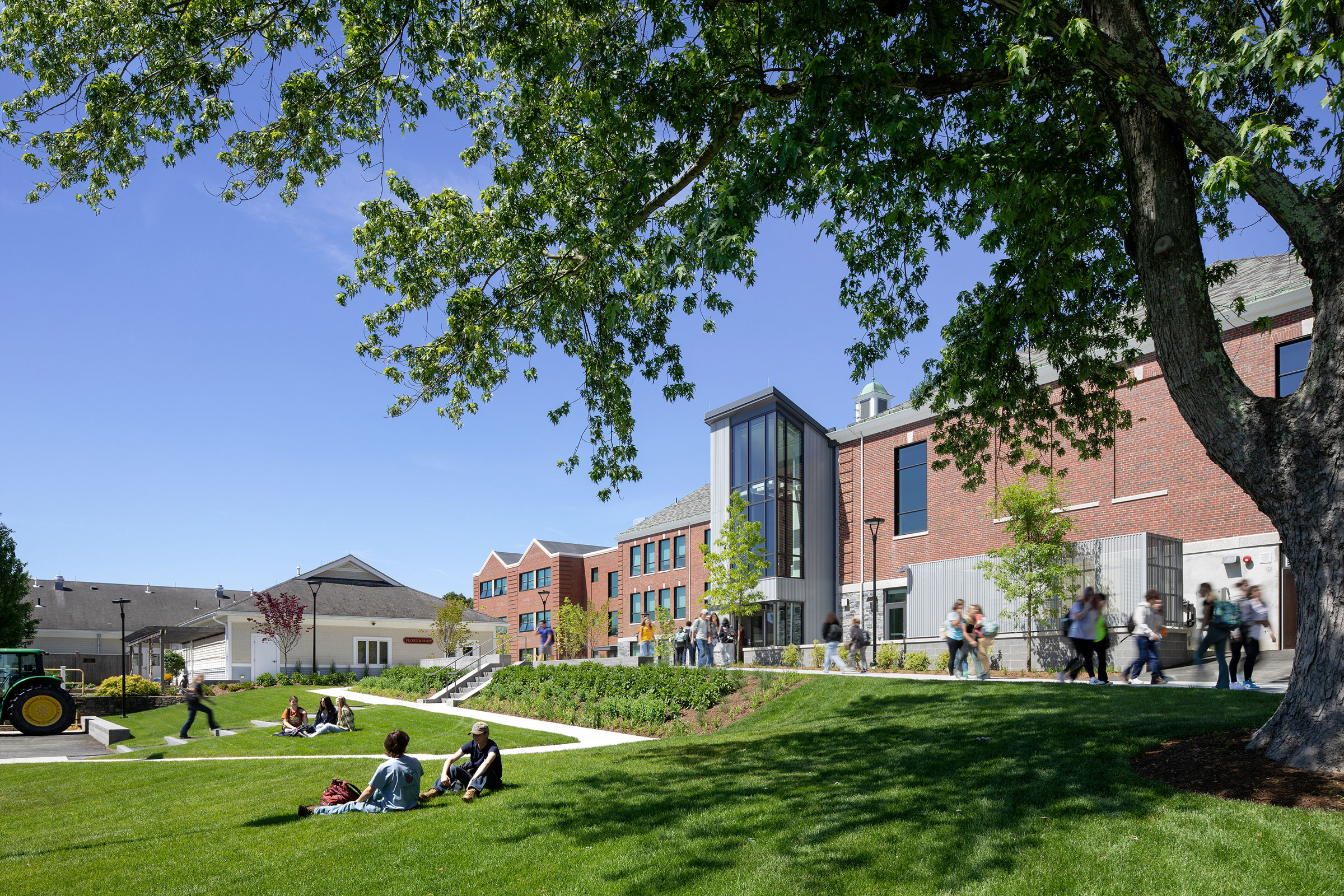Story at a glance:
- Sustainable building design is an architectural movement that seeks to reduce the immediate and long-term environmental impacts of buildings.
- In recent years sustainable building design has grown in popularity due to the lower operating costs and higher property values of green buildings.
- Seven core elements govern the sustainable design process: site and context, energy efficiency, water conservation, use of sustainable materials, improvement of indoor environment quality, social equity, and long-term performance.
Twenty-five years ago the demand for sustainable building design skyrocketed. To the uninformed observer this push toward eco-friendly architecture may have seemed rather spontaneous. In reality the sudden proliferation of sustainable design was a response to early efforts at carbon reduction as a means of limiting pollution and addressing global warming.
As we begin to better understand the causes and effects of climate change, energy-efficient buildings have become more popular than ever due to their reduced environmental impact and lower operating costs.
What is Sustainable Building Design?

Finland’s Lighthouse Joensuu is constructed primarily from mass timber, a strong, highly sustainable material that sequesters carbon throughout its operational lifespan. Photo courtesy of Arcadia
Sustainable building design is, put simply, an environmentally conscious way of approaching the architectural process—one that puts sustainability at the forefront of each building phase to ensure optimal building performance and minimize the negative human and environmental impacts associated with the built environment.
In practice sustainable design seeks to construct buildings with a neutral or positive impact by ensuring they operate at peak efficiency, are built using nontoxic, renewable (or recycled) materials, and work with—rather than against—the surrounding biosphere.
Green building certification programs like LEED, BREEAM, Passive House, and the Living Building Challenge provide guiding frameworks for architects, engineers, and urban planners to reference when designing sustainable buildings.
Why is Sustainable Building Design Important?
But in a world where the word “sustainability” is often thrown around, it can be difficult to understand exactly why sustainable design is so important. Aside from the fact that green buildings produce less carbon emissions, sustainable design helps to conserve water, reduce energy usage, and prioritizes the health of human occupants and the environment by limiting the use of toxic building materials.
Overall this conscious approach to building design helps ensure future generations’ well-being by protecting their access to non-renewable resources and reducing harmful emissions—without compromising our present-day needs. Sustainable building design is a necessary step in combating anthropogenic climate change and is key to reducing the built environment’s impact on the natural world.
When done correctly, green design is not only an environmentally sound practice, but one that helps reduce operating costs, improve occupant health, strengthen communities, and bolster long-term property value.
Benefits of Sustainable Building Design
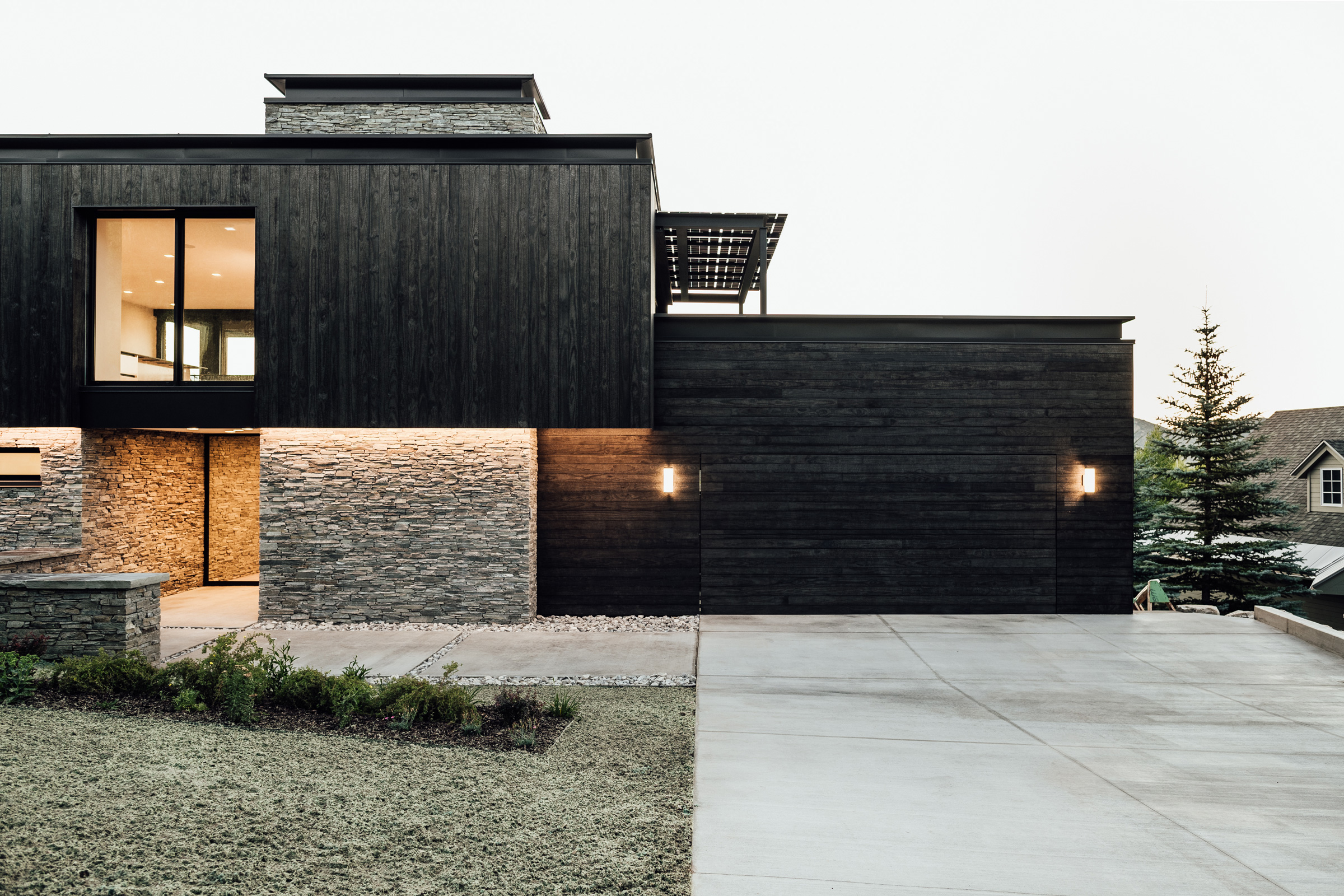
Whether it’s a reduced carbon footprint or lower operating costs, sustainable building design offers many benefits. Photo courtesy of Delta Millworks
These are some of the advantages of implementing green building practices during and after the initial construction process.
Reduced Environmental Impact
The main benefit of sustainable building design is that it reduces a structure’s overall environmental impact, both at the time of construction and throughout its life cycle. Green buildings are designed to offset their carbon emissions and waste production by generating their own renewable energy, recycling resources (e.g. water), and minimizing routine maintenance.
Improved Indoor Air Quality
Another advantage of sustainable building design is that it helps improve indoor air quality by reducing the amount of toxins, such as CO2 and VOCs (volatile organic compounds), released by building materials. Traditional polystyrene or fiberglass insulation, for example, can leach VOCs into the air over time—to avoid this, green buildings may use natural insulators such as hemp or cotton.
Green building design also seeks to maximize airflow and minimize ambient humidity, which in turn helps reduce the risk of mildew and mold growth, both of which can negatively impact the respiratory system.
Lower Operating Costs
Sustainable buildings also have lower operating costs due to the fact that they are engineered to minimize water and electricity usage. How much lower, you ask? Energy-efficient structures save approximately 25% on utility bills when compared to buildings without these energy-saving measures, according to the DOE.
These reduced operating costs help offset the initial expense of green buildings, which typically cost more to build than their traditional counterparts.
Improved Occupant Health and Productivity
In reducing the use of toxic building materials and limiting moisture buildup, green buildings ultimately improve the health of their occupants by minimizing the risk of developing debilitating respiratory illnesses and certain cancers. Natural sunlight, a comfortable micro-climate, and a stronger connection to the natural world further serve to improve an occupant’s mental state.
As a result of improved physical and mental health, occupant productivity also increases when living or working in a sustainably-designed building.
Increased Property Value
Lastly, the addition of sustainable features positively affects a building’s resale value. Don’t believe us? A 2019 study conducted by Freddie Mac found that homes with energy-efficient upgrades sold for approximately 2.7% more than homes without high energy-efficiency ratings—and they typically sold faster, too.
This is largely due to the fact that sustainable homes are a hot commodity: buyers want homes with a low environmental impact, because those features will save them money in the long run.
The Challenges of Sustainable Building Design

WRNS Studio designed the new UC Merced Arts and Computational Sciences Building in Merced, California around diversity and wellness. Photo by Celso Rojas
Sustainable building design is not, however, without its challenges, especially when projects are slated to be built in heavily urbanized areas with strict or outdated regulations.
Cost Barriers
Sustainable buildings often cost more to build at the outset than their non-sustainable counterparts, In fact, the average green building costs 2% more to build than a conventional building. This is largely because high-quality sustainable materials aren’t yet as numerous as traditional building products, which means competition for available materials is high. Projects aiming for LEED certification can also add $10,000 to more than $30,000 to the overall expense depending on how large the project is, as inspectors charge by the square foot.
Sustainable buildings also require specialized professionals to be involved in the planning process—and those architects and engineers knowledgeable in green design are in high demand, which means they can charge a higher rate.
However, it may be possible to alleviate cost barriers in part through the implementation of government-funded programs. We already see this in the US with various government assistance programs for constructing or retrofitting energy-efficient buildings.
Regulatory Barriers
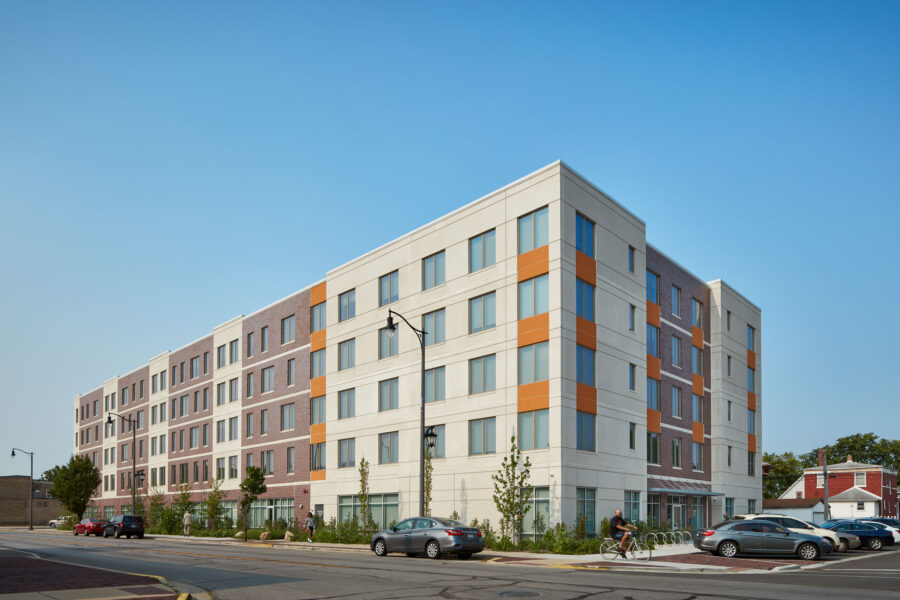
The 72-unit affordable housing project Fifth Avenue Apartments was selected in 2018 to participate in the Living Building Challenge’s affordable housing pilot program. The homes were designed to achieve the program’s criteria, though they were ultimately not able to achieve the certification due to financial and regulatory barriers. Photo courtesy of HED
Many cities, states, and countries also have building regulations that may hinder the design and construction of sustainable structures. The Bullitt Center in Seattle, for example, ran into one such issue due to its UV-light rainwater purification system, as the city requires water be treated with chlorine for purification purposes. Other sustainable building projects run into regulatory barriers before they even start construction, as existing building codes and regulations are often ill-equipped to deal with emerging green technologies.
Similarly, outdated government policies and strict regulations often make it difficult to adapt an existing building’s use and broaden their functionality, hindering the development of multi-use structures—a practice that can help reduce construction waste and make efficient use of limited urban spaces.
These regulatory barriers can be remedied by involving more sustainability professionals in the committees that oversee building code reevaluations—something that is, admittedly, easier said than done, as building codes are determined at the state and local level, which makes enacting widespread regulation changes a bit more challenging.
Lack of Awareness & Education
Another challenge to sustainable design is the general lack of awareness and education surrounding the field itself, particularly amongst industry professionals and the general populace as a whole. Despite the growing popularity of green design there’s still a comparatively low number of designers, architects, engineers, and construction companies that have experience working with the materials and technologies associated with sustainable architecture.
Many misconceptions also surround sustainable building design, especially when it comes to cost. While green buildings have a marginally more expensive upfront cost than their traditional counterparts, most responders overestimated the cost of green buildings by 15 percentage points, according to a survey conducted by the World Business Council for Sustainable Development.
Lack of awareness and education can be addressed in part by updating existing training and certification programs to include recent innovations in sustainable design. This would help to expand the pool of qualified professionals, which could in turn take on a greater number of projects. Forging international connections and shared databases in the architectural and design worlds could also help disseminate new ideas, advancements, and products at a faster rate.
Gentrification
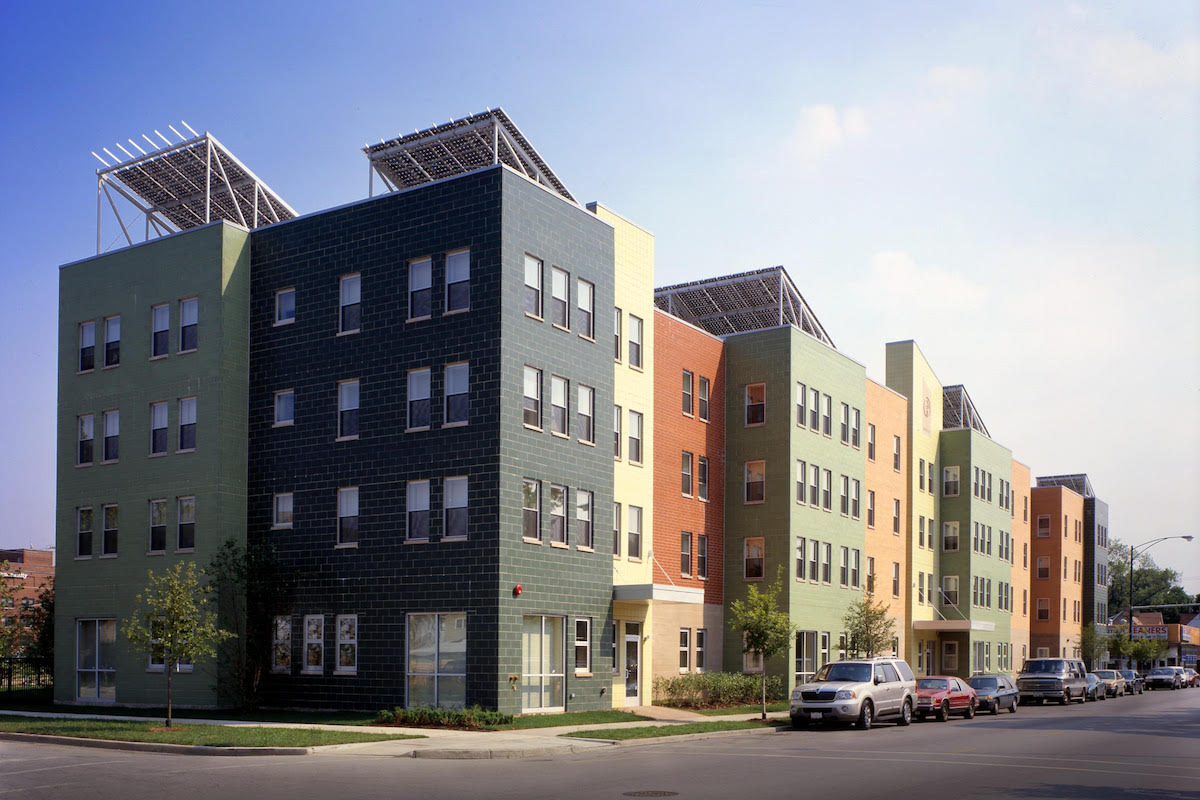
Sustainable housing projects like Wentworth Commons help combat gentrification by offering affordable housing opportunities. Photo courtesy of HED
Sometimes sustainable building design and construction has been coupled with gentrification. When sustainable projects are established in existing urban areas, the very qualities that make those areas desirable often lead to increased property values, which may price out the area’s low-income residents. As a result these residents are forced to find housing elsewhere, often in areas with poor sustainability scores; in short, inequitable design of sustainable building projects effectively excludes a large demographic from actually enjoying their benefits.
Sustainable projects should include a variety of affordable housing options beyond the single-family home or high-rise apartment. Multi-family homes, duplexes, townhomes, and other missing-middle housing types are a few examples of how sustainable housing can be made more inclusive of low-income, multi-generational, and non-traditional families.
The 7 Principles of Sustainable Design
What makes a building sustainable? What factors are architects prioritizing and what principles govern their decisions? Here are seven important principles.
1. Consideration of Site & Context
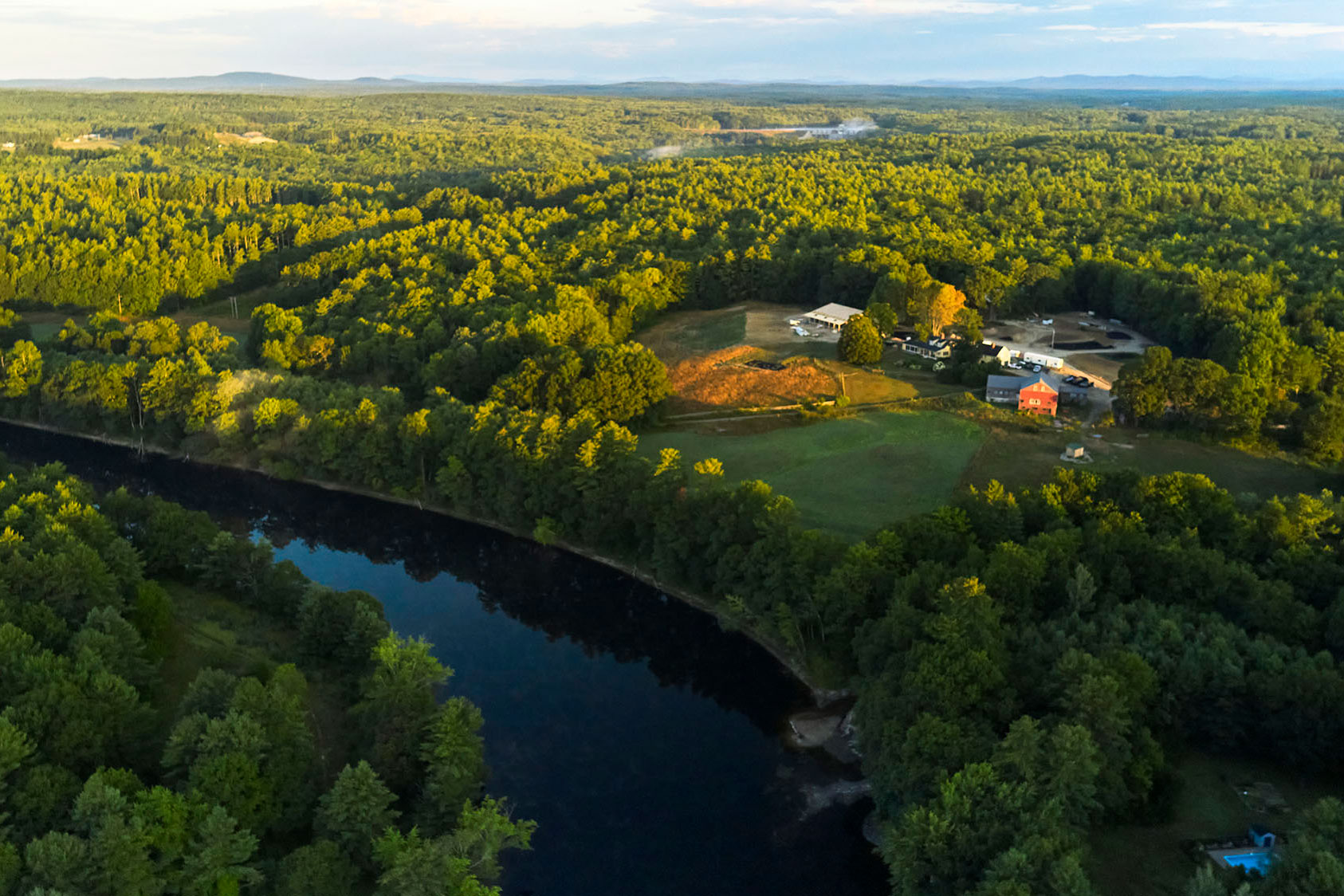
The Ecology School will come to life thanks to the efforts of Kaplan Thompson Architects, Scott Simons Architects, Briburn, and Richardson & Associates. The firms partnered with landscape ecology analysts to understand the site’s potential and the school’s goals for improving every inch of its diverse riverfront property. Courtesy of Kaplan Thompson Architects
As perhaps the most important principle of sustainable design, the site and context of a planned structure is key to maximizing its overall efficiency and performance. Site and context determines everything from the building’s orientation and the materials that may be used to which passive design features are actually feasible and which energy sources are going to be the most efficient.
“Increasingly architects and designers are realizing that building designs need to reflect the conditions of the area in which they are located,” Prasoon Shrivastava, CEO and founder of Prasoon Design Studio, previously wrote for gb&d. “For example, buildings in warm climates should utilize tinted windows to cool off the space, rather than air conditioning units.” In designing with local climatic factors in mind, architects are able to both reduce their projects’ carbon emissions and create healthier spaces for their clients, Shrivastava says.
2. Reduced Energy Usage

Each room in Solar Branco is thoughtfully appointed. The hotel gives guests real-time visibility of their energy usage to encourage them to use only what they need. Photo by Rui Soares
Reduced energy dependency—especially with regard to non-renewable energy sources—is another hallmark of green building design. This is often achieved by installing solar panels, well-placed windows or skylights that make the most efficient use of natural sunlight, and energy-efficient appliances.
It also means making sure the right insulation is used and that windows are sealed properly—both of which help maintain a consistent indoor temperature.
3. Water Conservation
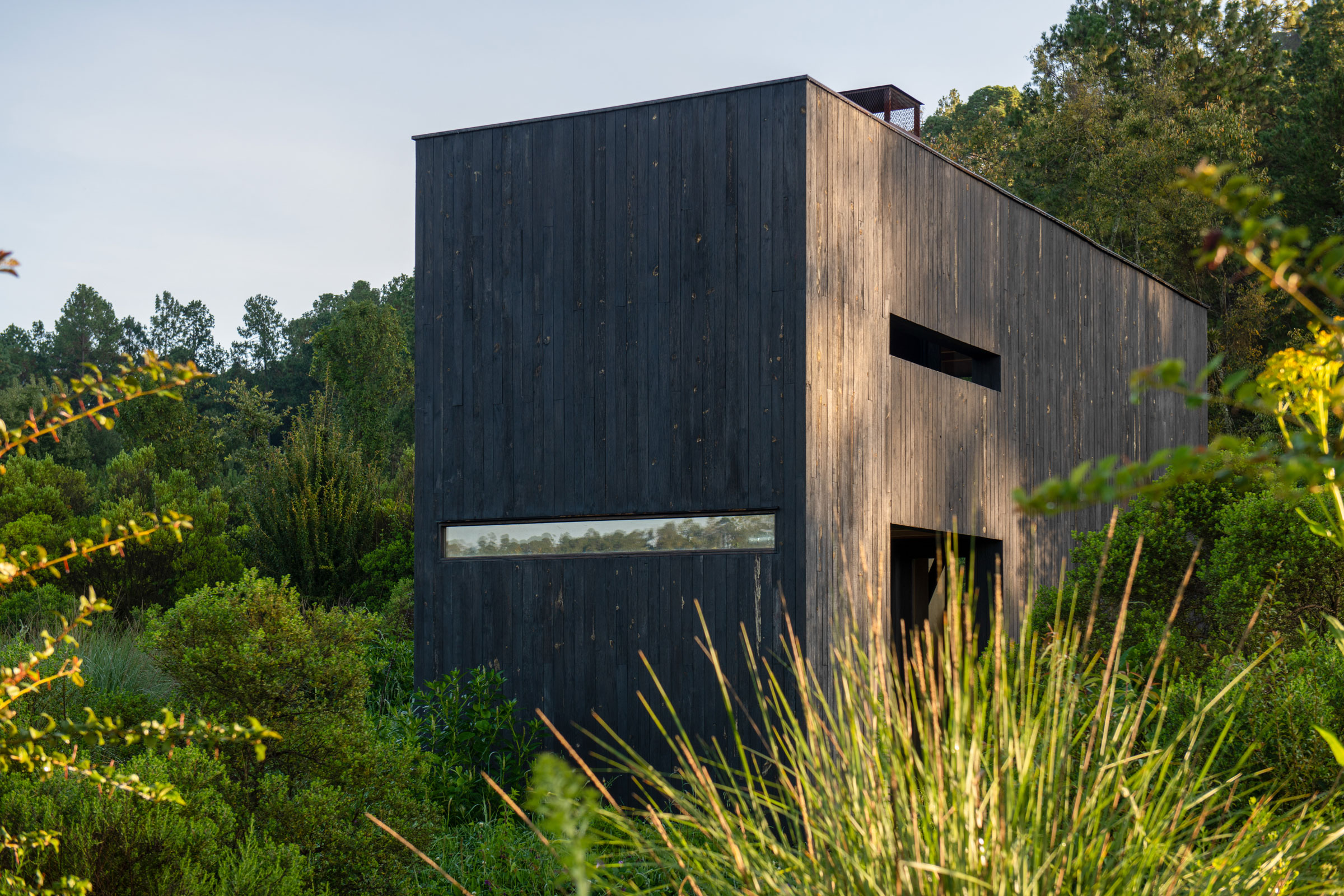
The Rain Harvest Home project is made up of three buildings that each collect rainwater to integrate with an above- and below-ground reservoir system. Photo by Jaime Navarro
Freshwater should be conserved wherever possible when designing sustainable structures. Green buildings typically achieve this by implementing effective plumbing systems, recycling black- and greywater on-site, and installing water-efficient taps/fittings and appliances.
Rainwater catchment systems that filter and store water that can later be reused to flush toilets, water gardens, and even fill washing machines are another common design feature in green buildings.
4. Use of Green & Recycled Materials
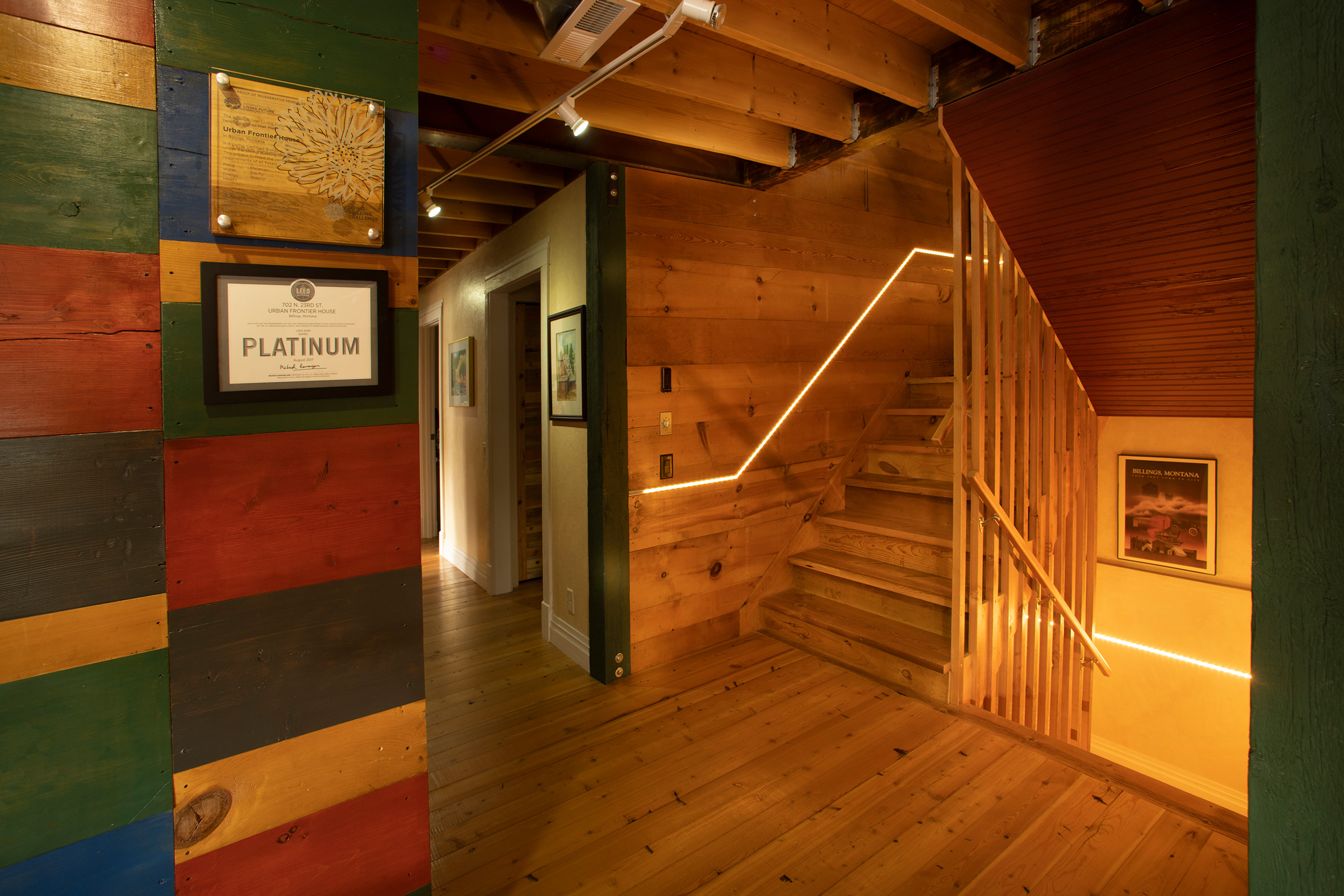
The wood products and paint used throughout Urban Frontier House are all free of Red List ingredients. Photo by Clark Marten
Green building design also places a high priority on using high-quality, eco-friendly materials (e.g. stone, timber, bamboo, adobe) and products in place of mass-produced, non-renewable building materials. These materials tend to have lower embodied carbon, create fewer GHG emissions during their procurement, processing, and manufacturing, and do not contain harmful chemicals or compounds.
When choosing materials or products for a project, verify whether they bear the Red List Free label. The International Living Future Institute’s Red List is a comprehensive guide to the “worst in class” chemicals, materials, and elements known to cause serious harm to human and ecosystem health. Red List Free products fully disclose 100% of their ingredients at or above 100 ppm in the final product and do not contain any chemicals on the Red List.
Recycled and reclaimed materials—particularly lumber, brick, and steel from demolished structures—are also used in sustainable building design whenever possible to mitigate waste production.
5. Improved Indoor Environmental Quality
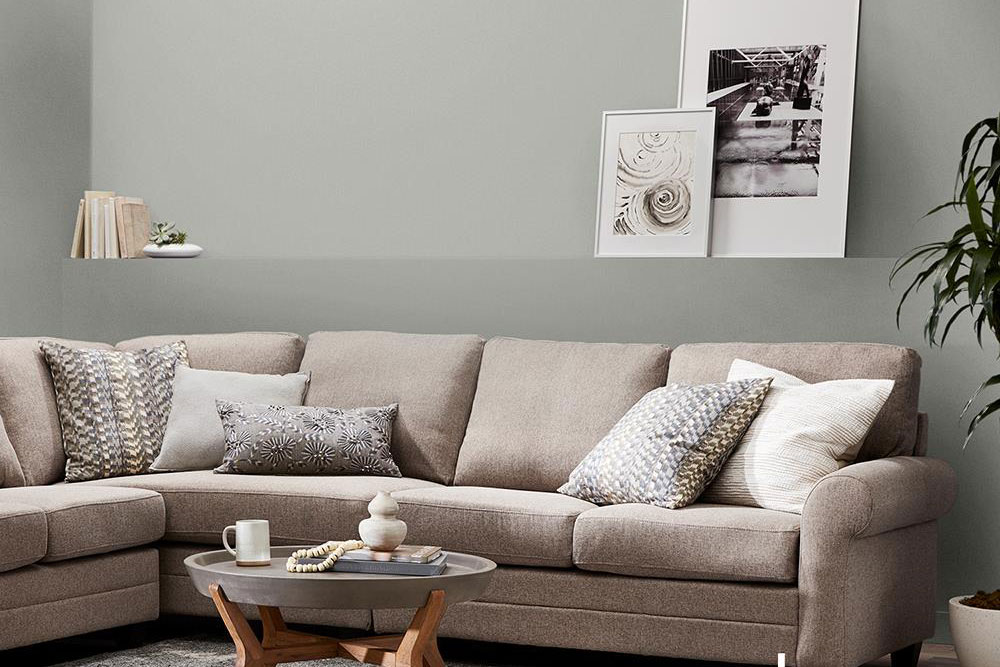
Valspar’s Signature paint is one of this brand’s low/no VOC offerings. Photo courtesy of Valspar
A healthy indoor environment is another integral component of sustainable design, especially when it comes to the occupant’s exposure to toxic chemicals. A healthy indoor space goes hand-in-hand with the use of eco-friendly materials, which typically produce lower levels of VOCs than traditional building materials.
Green buildings also seek to provide comfort and bolster productivity—both of which may be achieved by maximizing daylight and ensuring that the building’s layout effectively uses natural ventilation to maintain a pleasant micro-climate.
6. Resiliency & Long-Term Performance
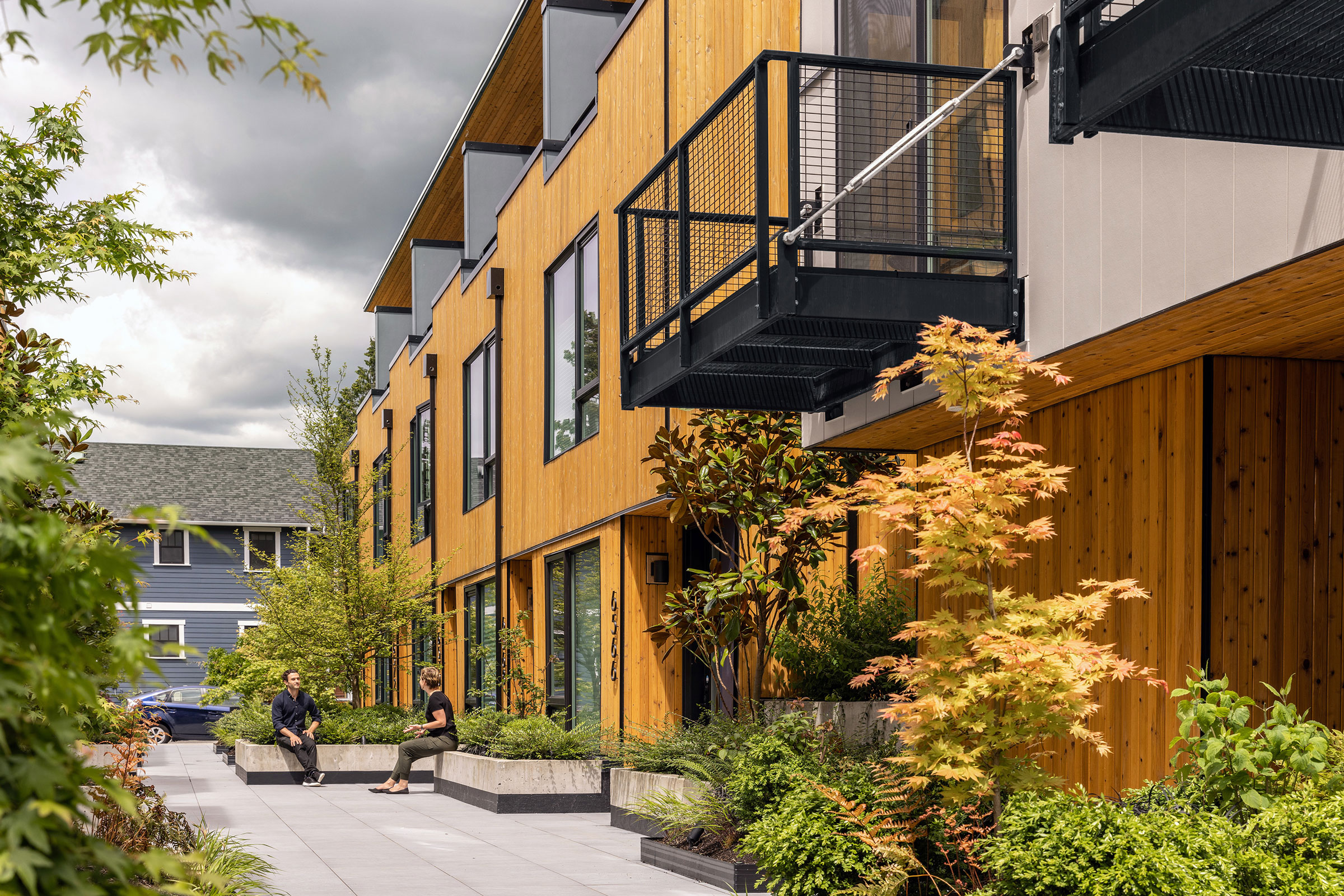
Winston Townhomes was designed by Johnston Architects to be both durable and long-lasting. Photo by Rafael Soldi
A big part of sustainable building design is designing structures that last—structures engineered to be as durable as possible. This helps minimize material waste and provides ample time for the structure to make up for the environmental impact incurred during its construction.
This is achieved largely through the use of durable, long-lasting materials with low maintenance requirements, such as rammed earth, stone, low-carbon concrete, and steel.
7. Promotion of Social Equity

The Night Ministry helps address social inequities in Chicago by providing overnight housing, housing support, warm meals, and healthcare services. Photo by Kendall McCaugherty, Hall + Merrick Photographers
Modern green building philosophy places a high importance on promoting social equity, too.
“In its most fundamental definition, equity looks at individual and community health and environmental justice and acknowledges that much of the world has benefitted less from economic development while bearing a disproportionate environmental burden,” David Bergman, program director of the Master of Professional Studies in Sustainable Interior Environments at NYSID, previously wrote for gb&d.
This is exemplified by the LEED rating system, which offers Social Equity Pilot Credits as a means of encouraging socially responsible building practices. These credits place an emphasis on working with the community impacted by the building project to ensure that needs and concerns are properly addressed.
Best Practices for Sustainable Building Design
Sustainable design may be successfully implemented in a variety of ways, and no two green buildings need be the same to be effective. As long as the following core practices are realized in some fashion, the possibilities are seemingly endless.
Conduct a Thorough Site Analysis
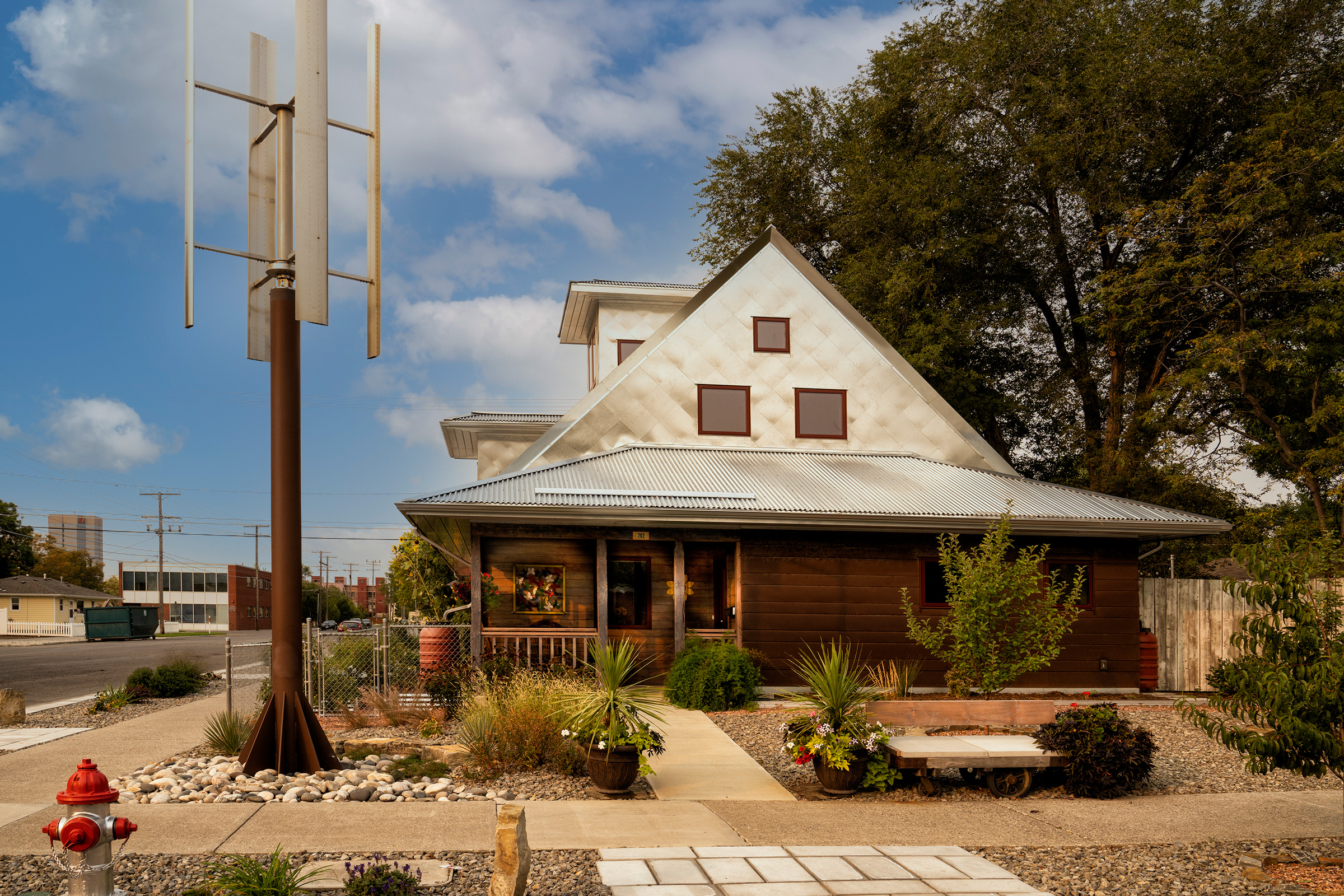
The LEED Platinum Urban Frontier House is a customized solution built by integrating existing systems in a new way to create a home that is scalable, replicable, and affordable. Photo by Clark Marten
The physical location of a building heavily influences its design, which is why it’s important that a thorough site analysis be conducted before the planning process even starts. This allows for a better understanding of the natural topography, local flora, and climate, which in turn informs the building’s layout, orientation, natural light requirements, and landscaping.
Practice Adaptive Reuse When Possible
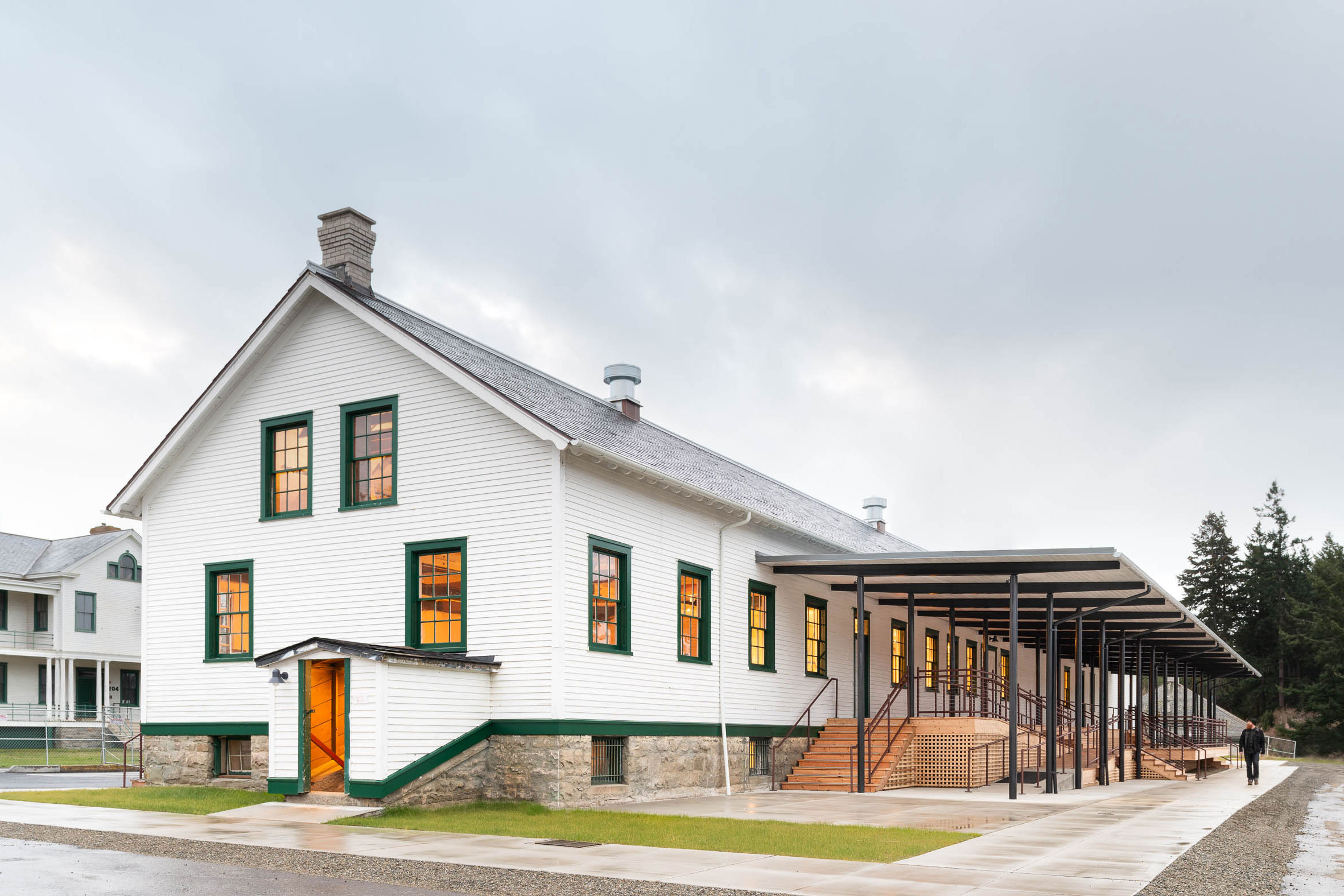
As an adaptive reuse project Fort Worden generates less carbon through its new use since it utilizes existing foundations and most of the walls, roofs, windows, and systems that enclose the building. The project on Washington’s Olympic Peninsula was designed by Signal Architecture with substantial input from local communities. Photo by Arthur Ross
Designing a building from the ground up can be done in a sustainable manner, but it will never be as sustainable as repurposing and renovating a building that already exists, a process known as adaptive reuse.
Adaptive reuse projects serve as a means of extending buildings’ operational lifespans by updating them to better address the economic and social needs of their respective communities. “Choosing to repurpose an existing building is a socially responsible and sustainable way to bring care closer to the communities that need it,” Aran McCarthy, principal of health care at FCA, previously wrote for gb&d.
Reusing existing buildings helps divert a significant amount of demolition waste from landfills and can even reduce construction costs by as much as 16%.
Choose Sustainable Materials
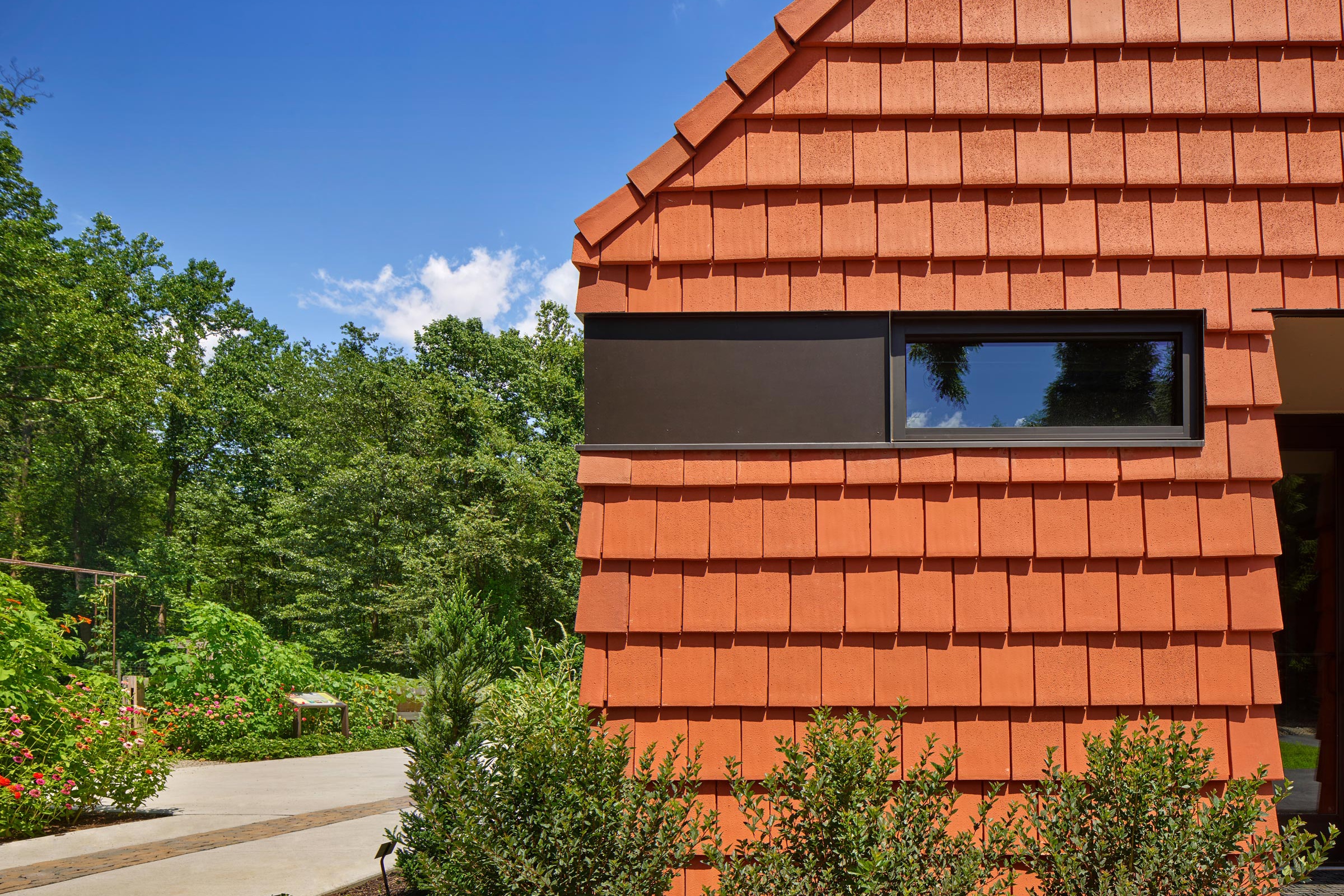
Tab Colbert, CEO of Ludowici, says terra-cotta is a “next level” sustainable material. Photo by Halkin Mason Photography
Choosing sustainable materials is an integral component of the green design process, one that is largely influenced by the building’s location and function. Low-carbon concrete, for example, is as structurally sound as high-carbon concrete, but has a lower environmental impact and high thermal mass, which can help reduce heating and cooling energy requirements.
Choosing sustainable materials also means knowing when to reuse existing materials—like reclaimed timber, salvaged windows, steel, or even drywall—as recycling material from prior building projects helps keep waste out of landfills.
Maximize Daylighting
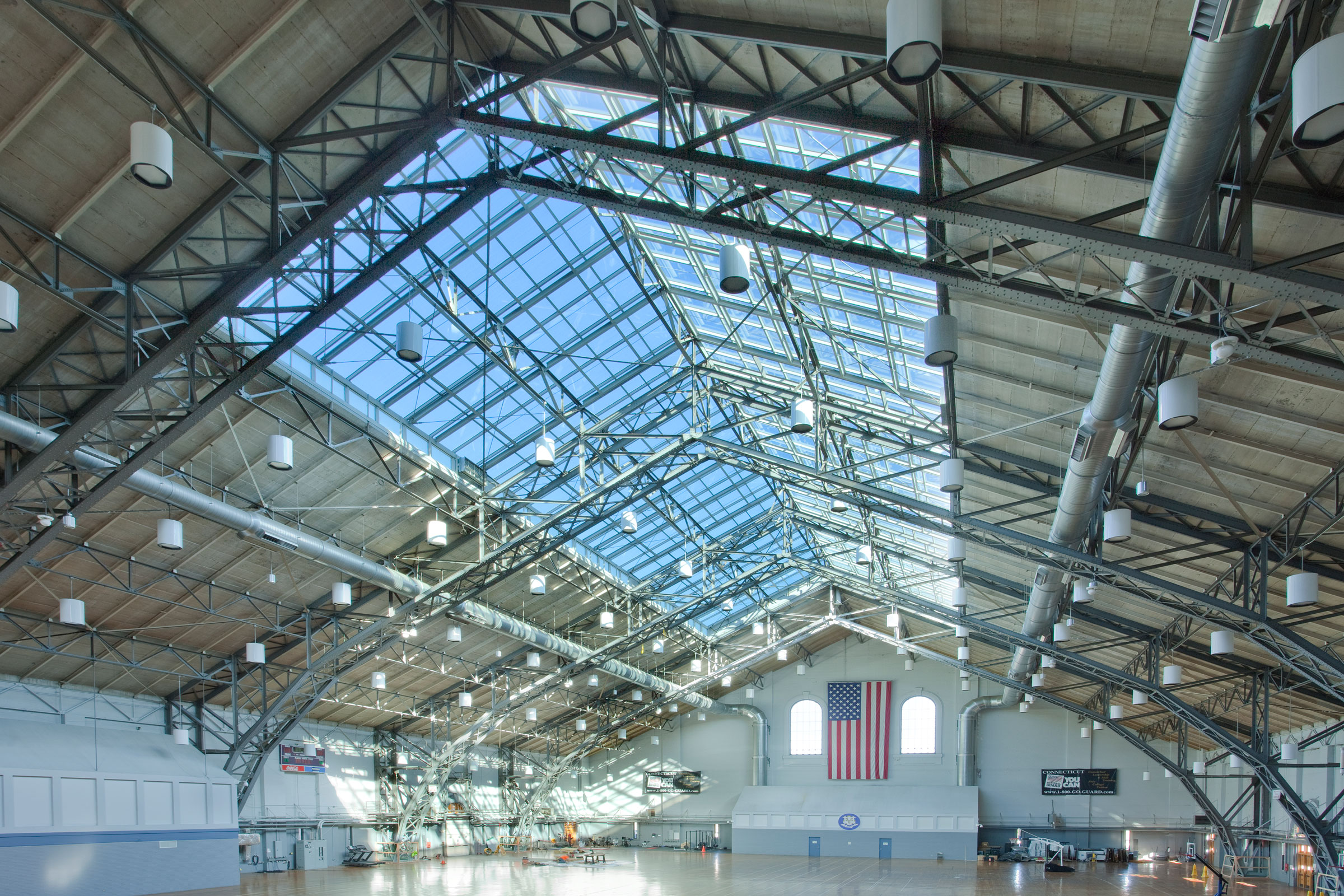
A metal-framed glass skylight is a focal point at the Hartford Armory. Photo courtesy of Kingspan Light + Air
In architecture daylighting simply refers to the practice of using natural sunlight—as opposed to electric light—to illuminate the interior of a building. By using windows, skylights, reflective surfaces, and other light-admitting features, daylighting can make effective use of indirect or direct sunlight to reduce a structure’s energy loads and operating costs.
Daylight is also crucial to maintaining the body’s circadian rhythm and is good for both occupants’ mental and physical health. “Exposure to natural light has been proven time and time again to have numerous benefits for people, from visual comfort to psychological and neurological benefits like improving mood, reducing stress, enhancing the body’s immune response, and allowing for better sleep,” Tori Wickard, senior project architect at Perkins&Will, previously told gb&d.
Utilize Passive Systems
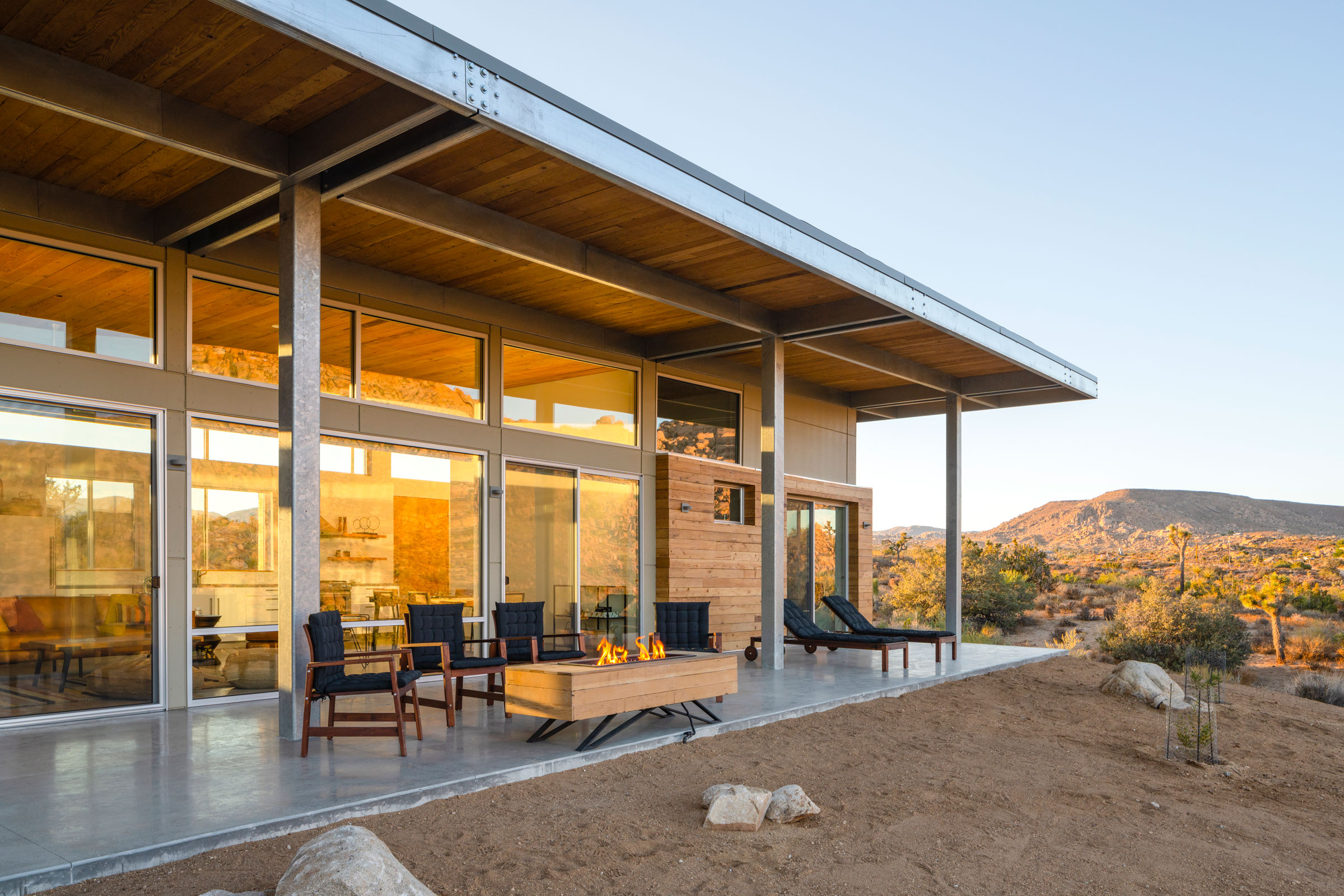
Designed by Jeremy Levine, the Cowboy Modern Desert Eco-Retreat uses passive solar design and wind-driven ventilation to reduce energy needs. Photo courtesy of Lance Gerber.
One of the most effective ways to reduce a building’s overall energy consumption is by incorporating passive systems in its design. In architecture passive design refers to those design strategies that allow buildings to make the most efficient use of natural environmental factors—e.g. wind, buoyancy, and solar energy—to reduce energy consumption.
Rather than rely on mechanical systems for heating, cooling, lighting, and ventilation, passive design enables a building to depend solely on the laws of nature to fulfill these crucial functions. Two of the most common passive design strategies are passive solar and passive ventilation:
- Passive Solar Design. Design in which a building’s walls, floors, and windows are made to reject solar heat during the summer and collect, store, reflect, and redistribute solar heat during the winter; informs everything from building orientation and window placement to the materials used in construction.
- Passive Ventilation. Refers to the process of supplying air to and removing air from an indoor space via the pressure/density differences arising from either wind or buoyancy; informs window placement and building layout.
Incorporate Renewable Energy
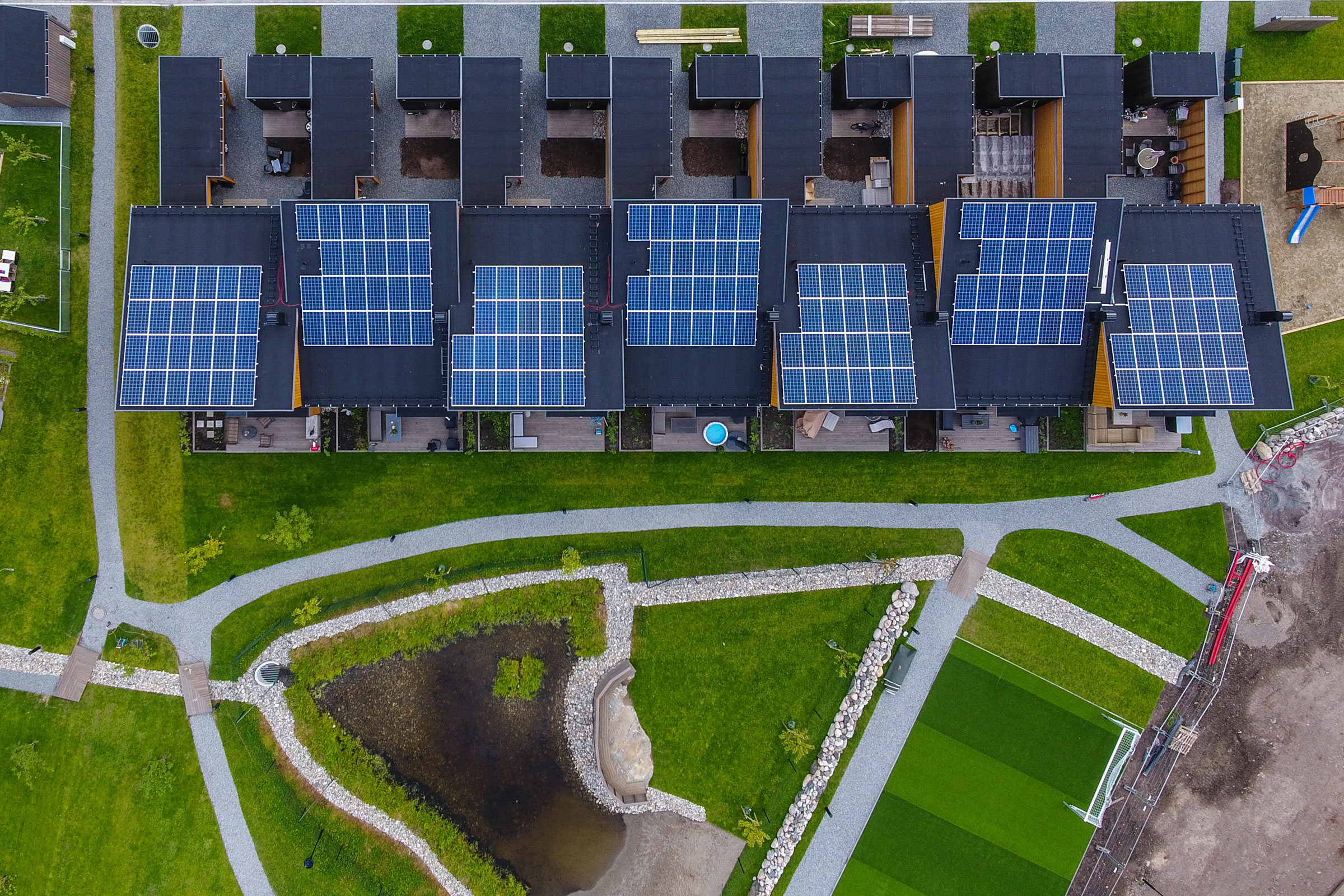
Otovo helps home owners find the best price and installer for solar panels, all without a home visit. Photo courtesy of Otovo
An ideal green building is capable of producing its own energy via renewable energy sources such as wind, solar, geothermal, or hydropower. Incorporating renewable energy into a building’s design is the first step in creating a zero-energy or positive-energy structure, which in turn reduces dependency on fossil fuels.
Solar is the most popular renewable energy source but is by no means the only option. The Urban Frontier House in Montana, for example, utilizes wind energy as well as solar, while countries like Iceland—which is powered almost exclusively by renewable energy—have demonstrated just how viable geothermal and hydro-power can be.
In the United States there exists both state and federal government incentive and assistance programs for a variety of renewable energies.
Optimize for Energy and Water Efficiency
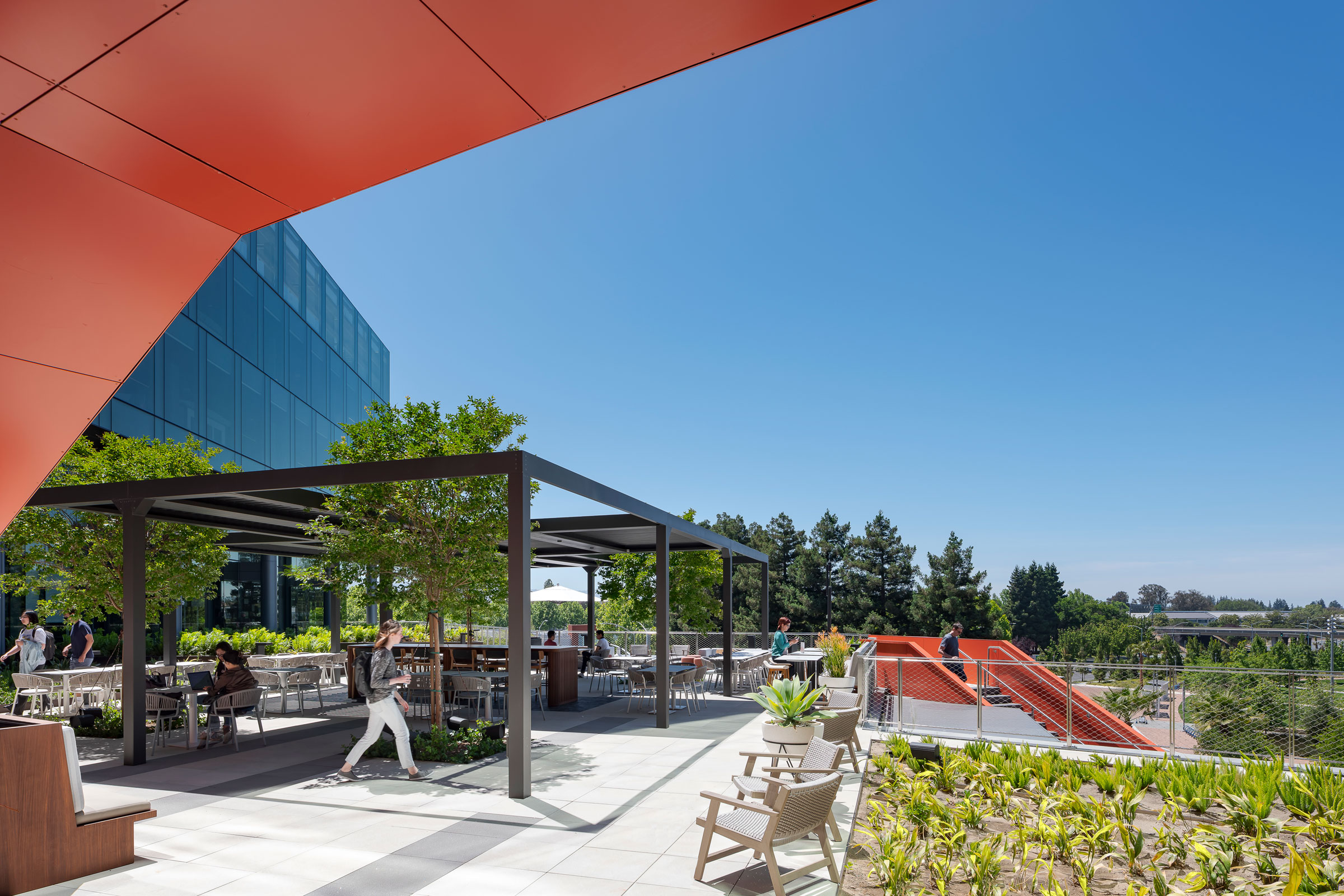
The landscaping and irrigation systems of the LinkedIn Middlefield project reduced potable water consumption for irrigation by 90%. Photo by Kyle Jeffers
Any successful sustainable building needs to implement certain design elements and technologies in order to maximize the structure’s energy efficiency. This can be achieved in part through the installation of ENERGY STAR certified appliances but largely depends on how well the structure is insulated, air-sealed, and whether it makes use of energy-efficient windows and doors.
Similarly, it’s important to reduce water usage as much as possible, something that may be accomplished through the installation of low-flow, WaterSense certified appliances and fixtures. Many sustainable buildings also incorporate some form of rainwater harvesting, a practice that can be as simple as collecting water for use in irrigation or as involved as purifying and treating rainwater for plumbing purposes.
Embrace Biophilia & Green Spaces
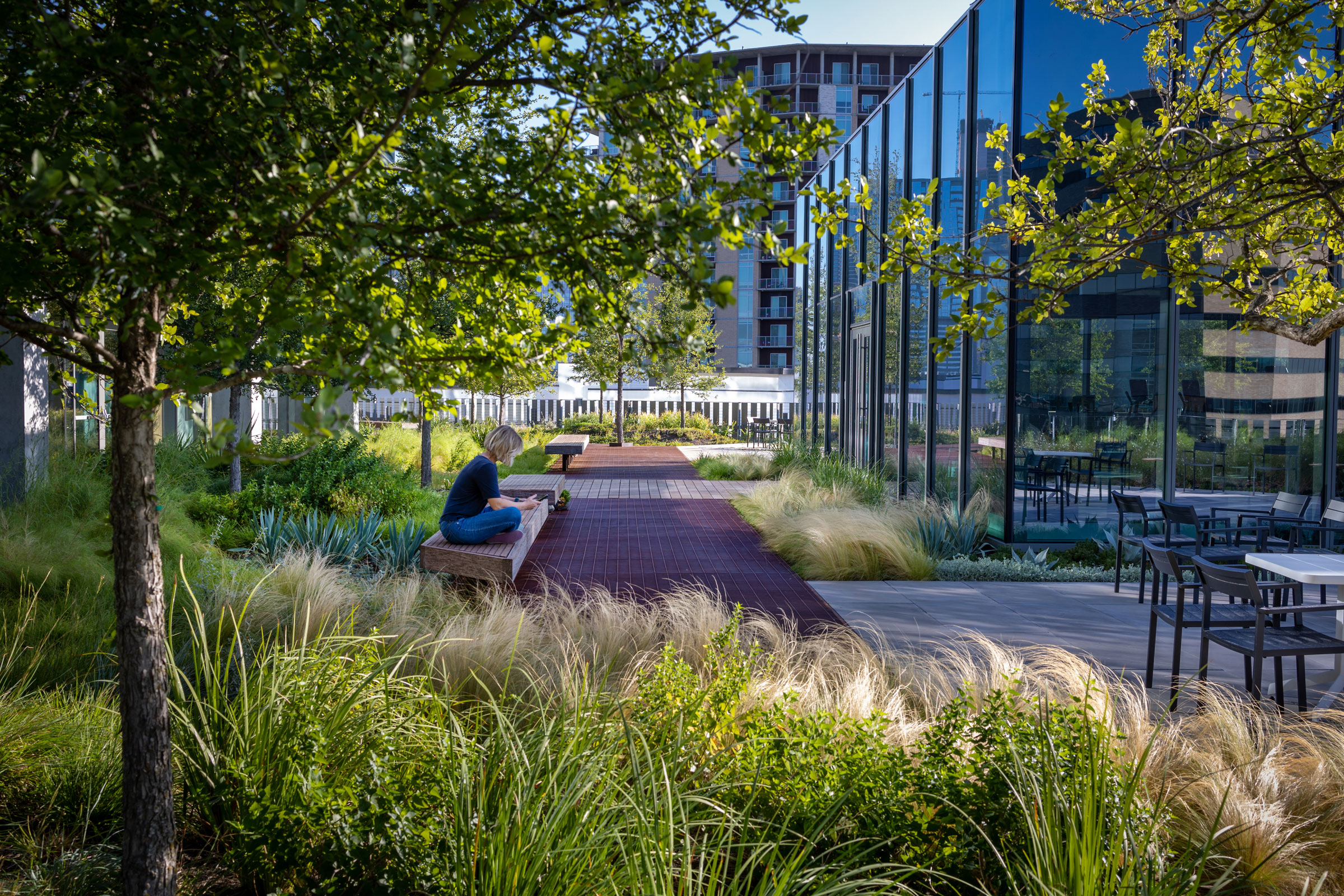
RiverSouth in Austin features a green roof that both keeps the building cool and gives people a place to escape. Photo by Casey Dunn
Biophilia or biophilic design seeks to connect a building’s occupants directly or indirectly to the environment and the natural world at large. The implementation of biophilic design principles is intended to foster a greater relationship with—along with a responsibility to protect—nature by promoting positive interactions between people and the environment.
We’ve already touched on some biophilic elements like daylighting and natural ventilation, but the most effective examples of biophilia help bring greenery into a space. Living walls and green roofs, for instance, can be a great addition to urban development projects that may otherwise lack access to nearby green spaces. These biophilic design features help provide natural cooling, mitigate excess stormwater runoff, and provide habitats for birds and insects.
Aside from helping to mitigate the urban heat island effect and improve air quality, green roofs and living walls also have positive psychological effects, such as lowering blood pressure, reducing feelings of stress, and improving alertness.
10 Examples of Sustainable Building Design
Now that we’ve a better understanding of the principles and realization of sustainable building design, let’s take a look at a few noteworthy examples from around the world.
1. Winston Townhomes, Seattle
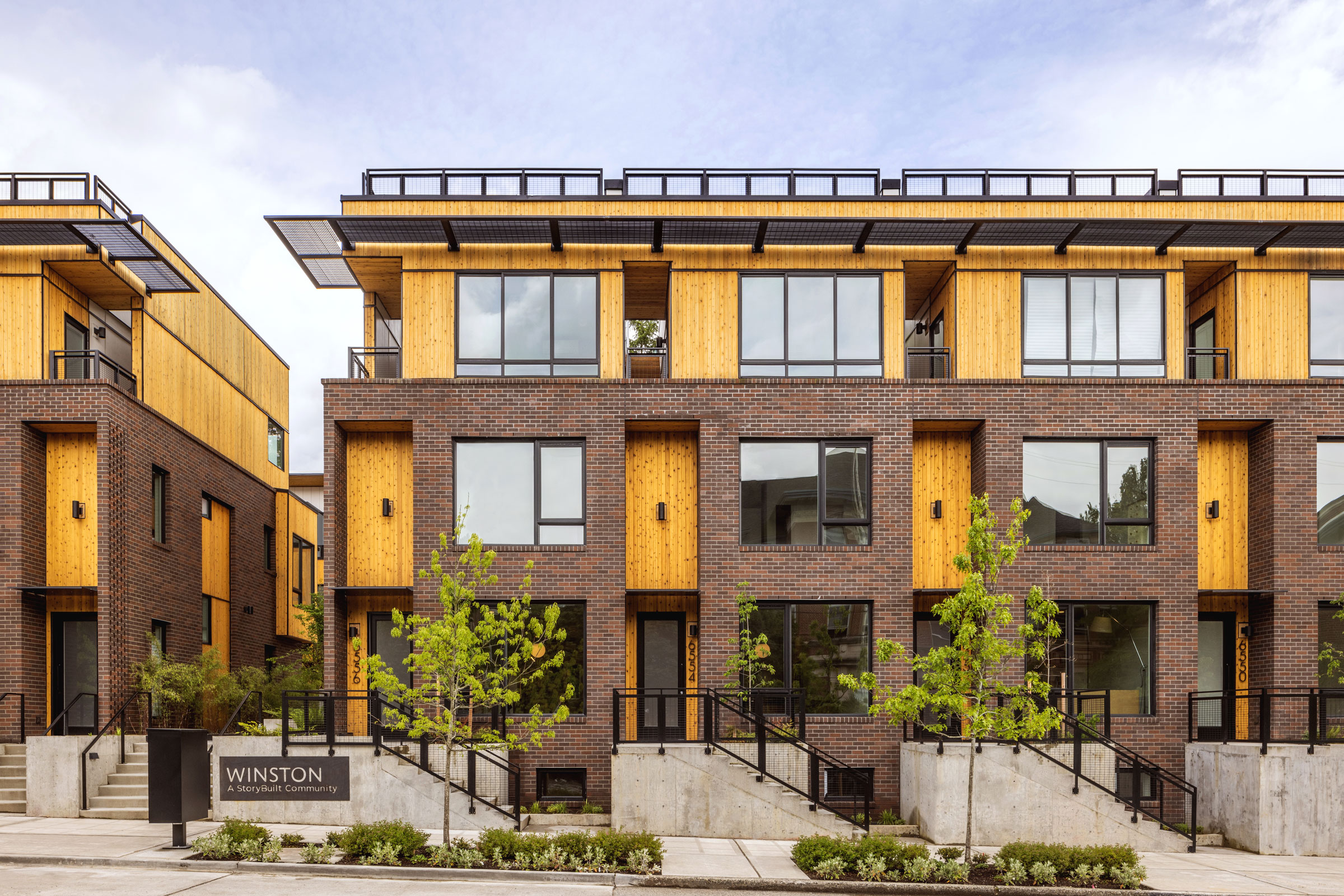
Winston Townhomes was designed by Johnston Architects with careful consideration of materials and the surrounding, single-family neighborhood in Seattle. Photo by Rafael Soldi
Designed by Johnston Architects (JA) in Seattle’s historic Ravenna neighborhood, the Winston Townhomes residential complex is the perfect example of how sustainable design can be achieved while still respecting the character and style of existing building stock.
Consisting of 16 new homes, Winston Townhomes features below-grade parking to conserve the property’s limited above-ground space for more environmentally friendly amenities, namely a south-opening courtyard in the middle of the project. The courtyard is planted with an extensive array of (mostly) native and drought-tolerant species that filter virtually all of the site’s stormwater and provide occupants with shade and privacy.
Inside Johnston Architects implemented a range of strategies to improve the building’s overall energy efficiency, including all-electric Energy Star appliances, heat recovery ventilators, and air-source heat pumps, as well as low-flow plumbing fixtures to help conserve water. Sunshades and operable windows designed to provide cross-ventilation also help to reduce the need for air conditioning. And while Winston Townhomes does not at present generate any of its own power via renewable sources, roughly 40% of its rooftops possess the necessary infrastructure to accommodate future installation of photovoltaic panels.
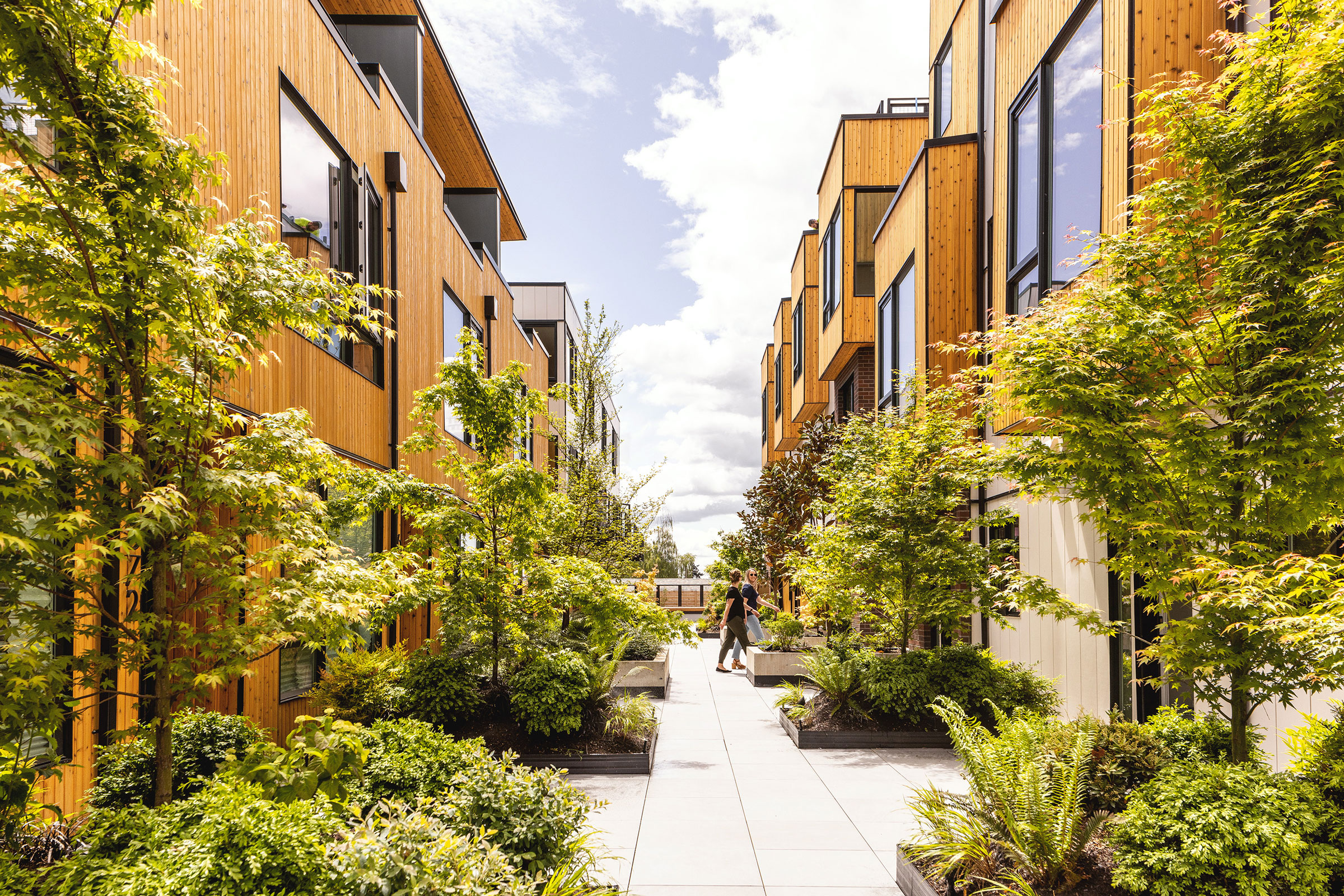
In the middle of the four residential buildings at Winston Townhomes is a courtyard. Photo by Rafael Soldi
One of the major challenges JA faced in designing Winston Townhomes was how to best go about complimenting the surrounding brick-clad buildings stylistically without actually cladding the entire residential complex in brick—a material that, despite being both durable and recyclable, is high in embodied carbon. The team’s solution was to limit the use of brick to where it mattered most, such as in the frames surrounding unit entryways or in the form of perforated brick privacy screens along the western facade, paired with the use of textural brick patterns on the building’s north and south facades.
Because Winston Townhomes compliments rather than contradicts the historic character of its host neighborhood, it is more likely to be embraced and cared for by the community, ensuring its longevity over time. “The longer a building lasts, the more it offsets its embodied carbon with savings in energy use. Most of the sustainable systems used in the project are not unusual in today’s multi-family market, especially in light of stricter codes,” Mary Johnston, a founding partner of Johnston Architects, previously wrote for gb&d. “However, it is the combination of these strategies—responsive site design paired with sensitive use of materials reflective of the scale, texture, and traditions of a neighborhood—that make Winston successful and sustainable on multiple levels.”
2. 799 Broadway, New York City
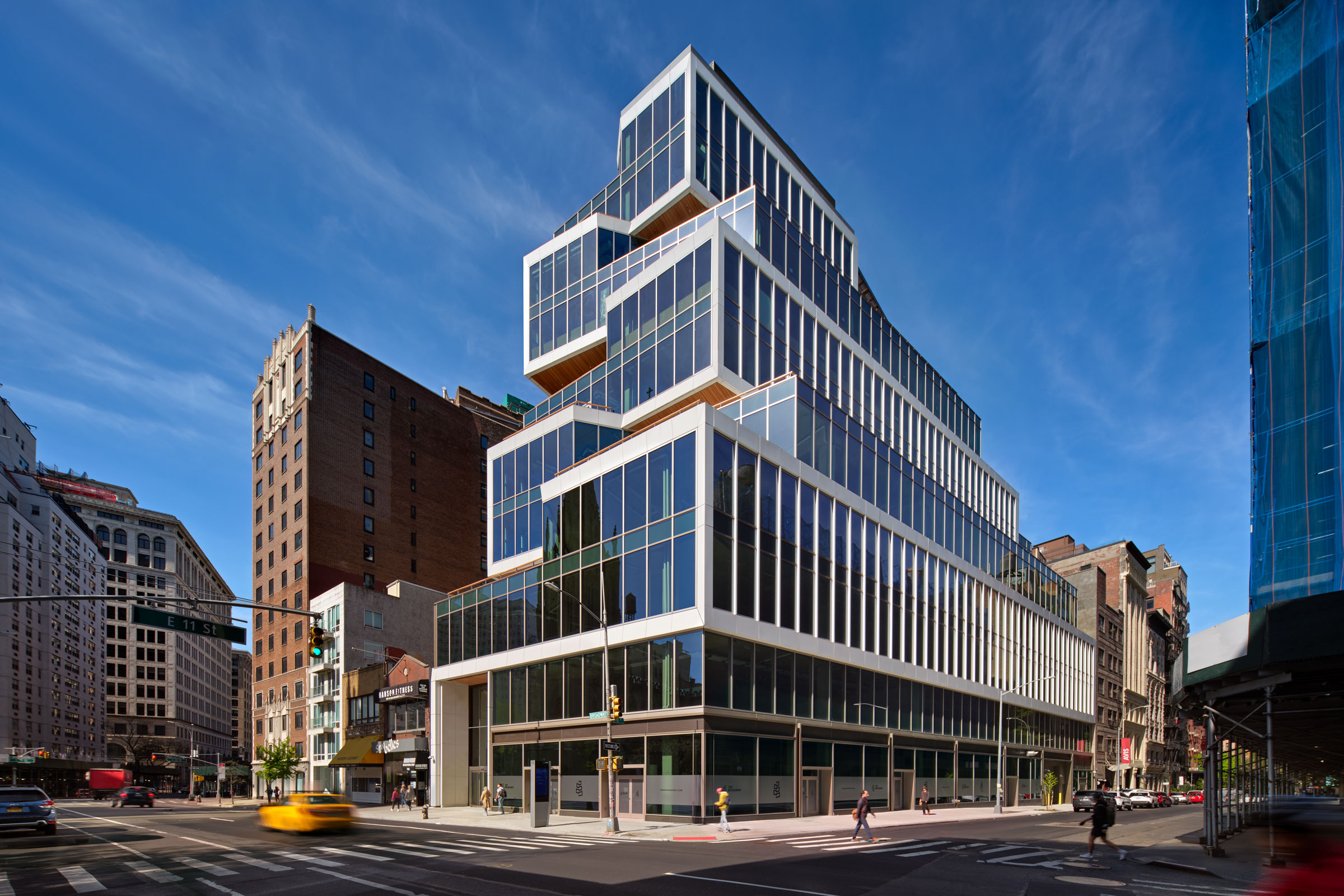
799 Broadway was designed by Perkins&Will to LEED Gold and WELL standards. The office building incorporates biophilic elements and features a 17,000-square-foot outdoor courtyard. Photo by Chris Cooper
Located in the heart of Brooklyn and designed by Perkins&Will, 799 Broadway sets the standard for what the future workplace should be—aesthetically-pleasing, worker-friendly, and environmentally-conscious. “You don’t separate design and sustainability; they are one in the same,” Robert Goodwin, design principal at Perkins&Will New York, previously told gb&d. “We always need to be considering energy efficiency, resiliency, regeneration, and occupant wellness. True sustainability requires a comprehensive approach.”
Designed to achieve both LEED Gold and WELL certification, 799 Broadway’s orientation and massing were informed by solar pathing and daylight analyses to help minimize the building’s heating and cooling needs. This led to the tower being oriented primarily to the east and north to reduce the need for external shading, while the limited use of south-facing glass allowed for a 10% reduction in the cooling tower load. The building’s high ceilings, narrow floor plates, open floor plan, and large windows flood the interior with natural light, further reducing energy consumption.
In an attempt to avoid the artificiality that so often befalls modern office design, Perkins&Will elected to incorporate biophilic elements wherever possible. Natural materials can be found throughout the interior and especially in the lobby, which features stone paneling and a faceted wood ceiling, subtly invoking the natural world from the moment one enters the building. In addition to the use of biophilic materials, nearly every level of the building boasts an outdoor terrace, while a 17,000-square-foot ground-floor courtyard brings a bit of greenery to an area otherwise lacking in green spaces.
Completed in 2022, 799 Broadway spans 12 floors and offers a total of 182,000 square feet of commercial office space.
3. Kempegowda International Airport Terminal 2, Bengaluru, India
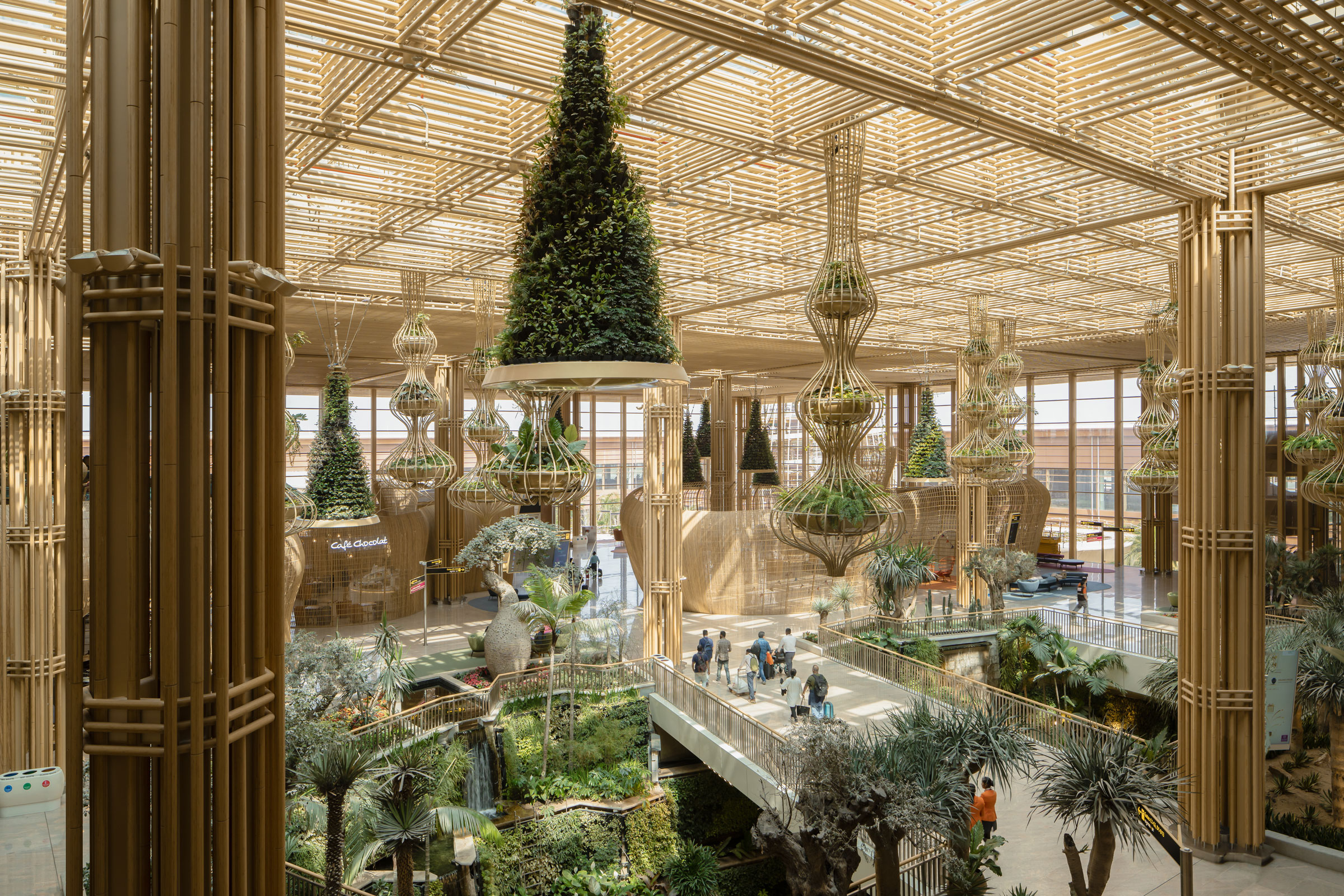
SOM worked closely with landscape architects at Grant Associates and lighting designers at BPI to balance the daylighting requirements of the plants and the energy loads of the Terminal 2 (T2) project at Kempegowda International Airport in India. Photo by Ekansh Goel, Studio Recall
Designed by Skidmore, Owings & Merrell (SOM), the Kempegowda International Airport Terminal 2 (T2) flips the concept of the modern airport terminal on its head and forces us to reevaluate how we think airports should look and feel.
Conceptualized first and foremost as a “terminal in a garden,” T2 was designed from the ground-up with biophilia in mind and the goal of connecting passengers to the natural world along each step of their journey. Hanging gardens greet travelers at check-in while plants, water features, and outdoor walkways can be found in abundance throughout the terminal as a whole, of which is lit almost exclusively by skylight-provided filtered daylight. All of the vegetation is irrigated with rainwater harvested on-site and indoor waterfalls help provide the interior with natural cooling.
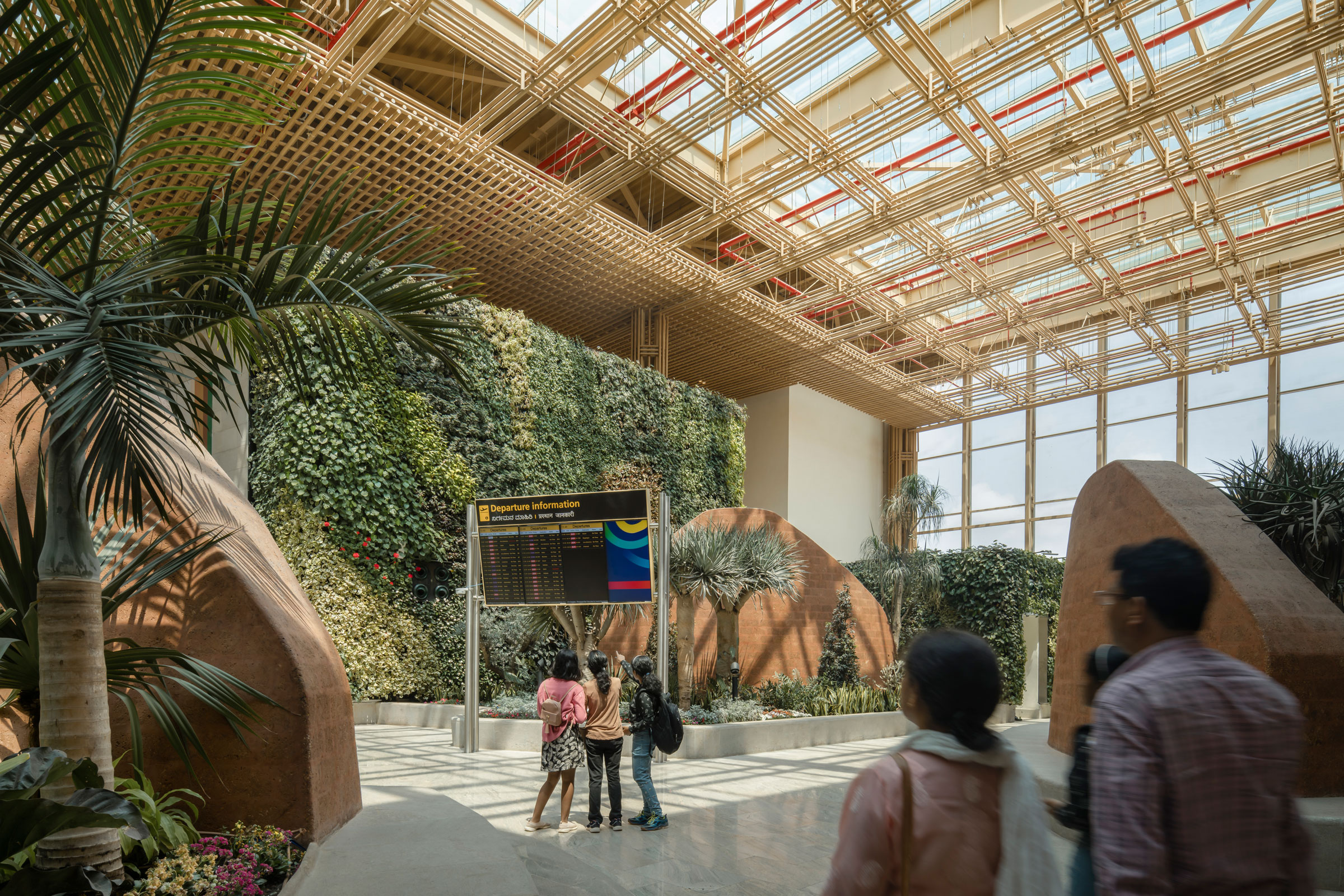
SOM designed the T2 project at Kempegowda International Airport in India to immerse passengers in hanging gardens, surrounded by plants and the soothing sounds of water. Photo by Ekansh Goel, Studio Recall
Natural, locally sourced building materials like brick, stone, rattan, and engineered bamboo further reinforce a connection to nature while reducing the terminal’s overall environmental footprint. “We also focused our engineering on reduced embodied carbon and designing a structure that maximizes the use of locally sourced materials,” Peter Lefkovits, design principal at SOM, previously wrote for gb&d. “We designed a small structural grid (only 18 meters by 18 meters) that supports the program spaces needed for 25 million annual passengers. Our smaller grid reduces the material needed and creates a lightness in the structure.”
In anticipation of future changes and evolving needs, SOM decided to build flexibility into the design of the terminal itself, ensuring long-term use and functionality. All of T2’s gates, for example, are set up to serve either a single wide-body or two narrow-body aircraft while the terminal’s concourses are designed to swing between domestic and international use, effectively allowing the airport to get double the use out of each gate.
4. Bristol County Agricultural High School, Dighton, MA
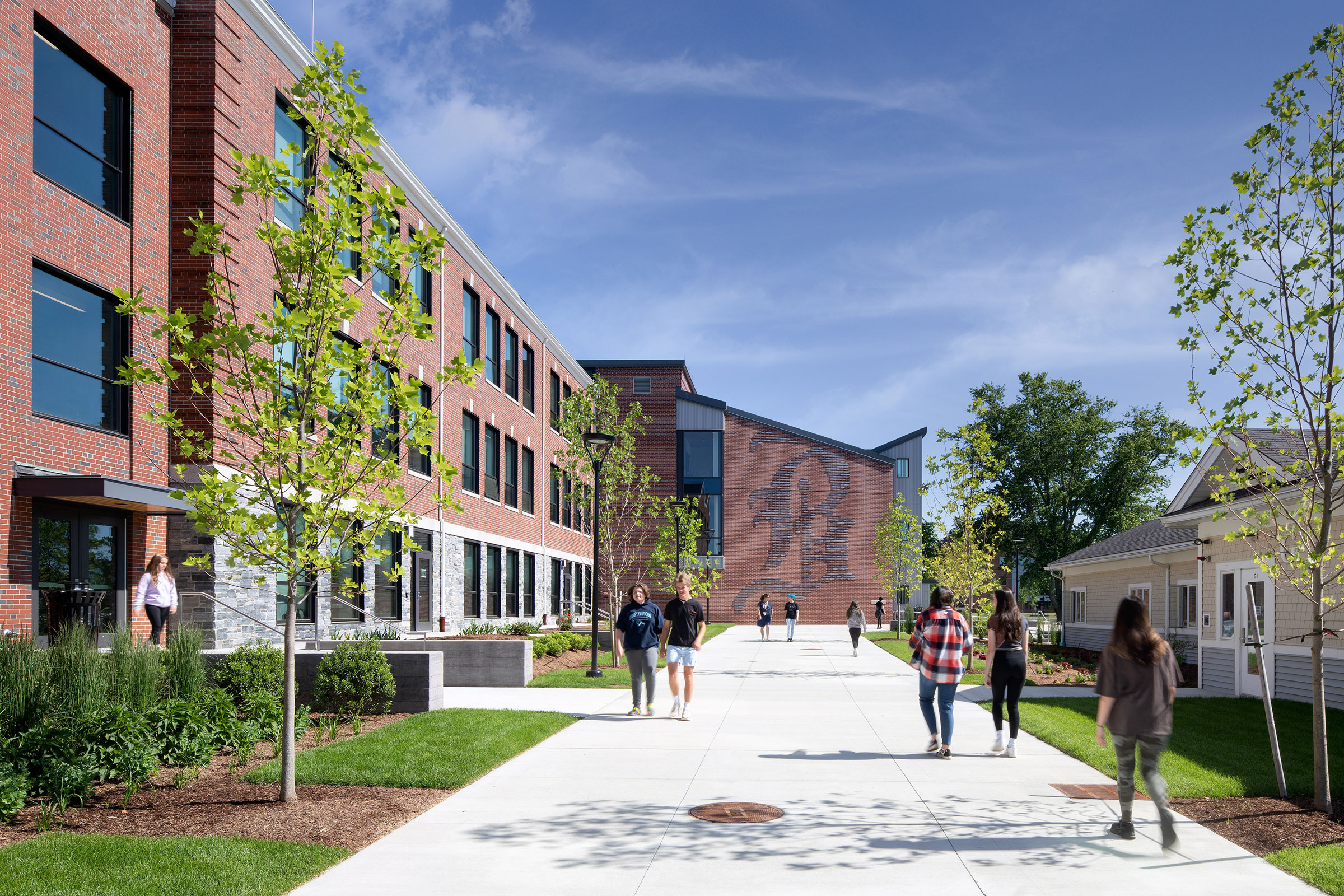
Gilbert Hall at Bristol County Agricultural High School was renovated by HMFH Architects to LEED Gold standards and reuses a large percentage of the building’s original materials. Photo by Ed Wonsek
Originally built in 1912, Bristol County Agricultural High School is one of only five agricultural high schools in the country—and thanks to its recent renovation and expansion by HMFH Architects, it is arguably the most sustainable of the lot. In total HMFH renovated two of the school’s existing buildings, Gilbert Hall and the Agricultural Mechanics building, with the former achieving LEED Gold certification in part thanks to its reuse of 69% of the building’s existing materials, which saved approximately 744 metric tons of carbon when compared to new construction.
HMFH’s expansion of the campus included a total of four buildings—the Dairy Barn, Center for Science and the Environment (CSE), Student Commons, and Landscape Arbor Building—as well as a small addition to Gilbert Hall. The Dairy Barn was designed to be net-zero ready and features state-of-the-art robotic milking technology while the new Student Commons is constructed from glulam, a low-carbon variety of mass timber technology.
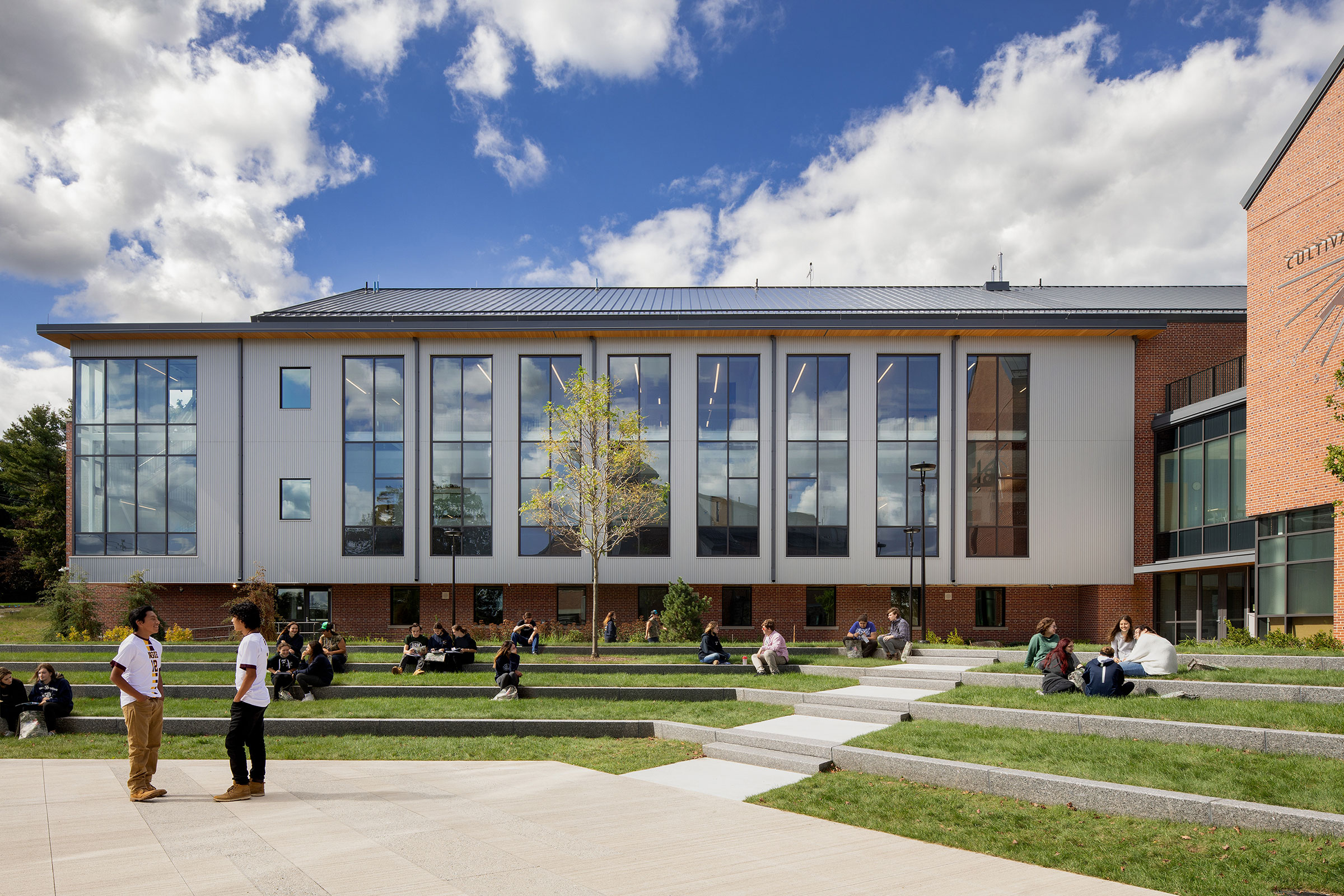
Bristol Aggie’s Center for Science and the Environment building is LEED Gold-certified, boasts two green roofs, and is key to managing the campus’ stormwater. Photo by Ed Wonsek
Out of all the new buildings, however, the CSE building is perhaps the most impressive. Designed to meet LEED Gold standards, the structure functions as a living learning center and houses flexible classrooms, specialized bio-secure labs, and even a natural resource museum curated by the students themselves. Two vegetative green roofs help promote biodiversity while a PV array supplies the building with a portion of its energy and strategically-oriented daylighting devices reduce heating, cooling, and lighting loads..
Because of the school’s proximity to the nearby Taunton River, the HMFH design team wanted to make sure that the campus would not negatively impact local aquatic habitats. “We put a lot of focus into understanding how to manage the water onsite,” Bobby Williams, associate principal at HMFH, told gb&d in a previous article. “For the new Center for Science and the Environment Building we have gutters that deliver water into rain gardens, a system that collects rainwater into a cistern that is used to irrigate the north side of the campus.” Bristol Aggie is also the first public school in Massachusetts to make use of composting toilets, of which provide water savings 68% over that required by code.
5. Solar Branco Eco Estate, São Miguel Island, Portugal
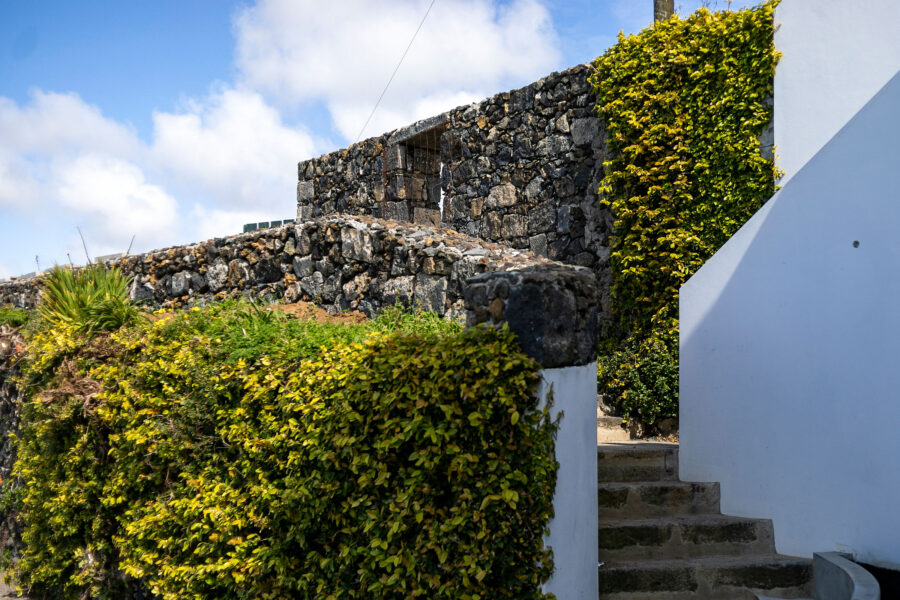
Today the property that is the Solar Branco Eco Estate is home to impressive grounds, from the flowers and fruit-bearing trees to the boutique hotel accommodations, restored ruins, and even a bit of an accidental animal refuge. Photo by Rui Soares
Originally built during the 19th century, the property that would eventually become the Solar Branco Eco Estate began its life as a farmstead and consisted of a main house, several outbuildings, livestock fields, and an orange grove. After succumbing to neglect over the years the property was bought in 2018 by Caroline Sprod and her husband Ali Bullock, who worked with architect Joana Oliveria from Mezzo Atelier to transform it into the sustainable hotel it is today.
“We found an architect we wanted to work with who grew up maybe two miles from here,” Caroline Sprod, co-owner of Solar Branco, told gb&d in a previous article. “She combines local features in a modern and minimalist way, which is a style that spoke to me. I felt we had the same understanding of what we wanted the place to look like.” Over the next couple of years Sprod, Bullock, and Oliveria were able to successfully renovate several of the property’s existing buildings, transforming an old farmyard storage shed into a two-story cottage, stables into the Gin Library and an accompanying speakeasy, as well as other abandoned farm structures into luxury guest rooms.
Any materials that could be salvaged were reused wherever possible, while materials that were still in usable condition but which didn’t fit the hotel’s vision—like some of the original shelving—were given to neighbors. “Typically in the construction industry here, the easiest thing is to scoop these things up in the back of the lorry and dump them in a landfill rather than make the effort to move them,” Sprod says. “We try to minimize any waste, and we wanted to be thoughtful about how we were treating the building and the contents in it.”
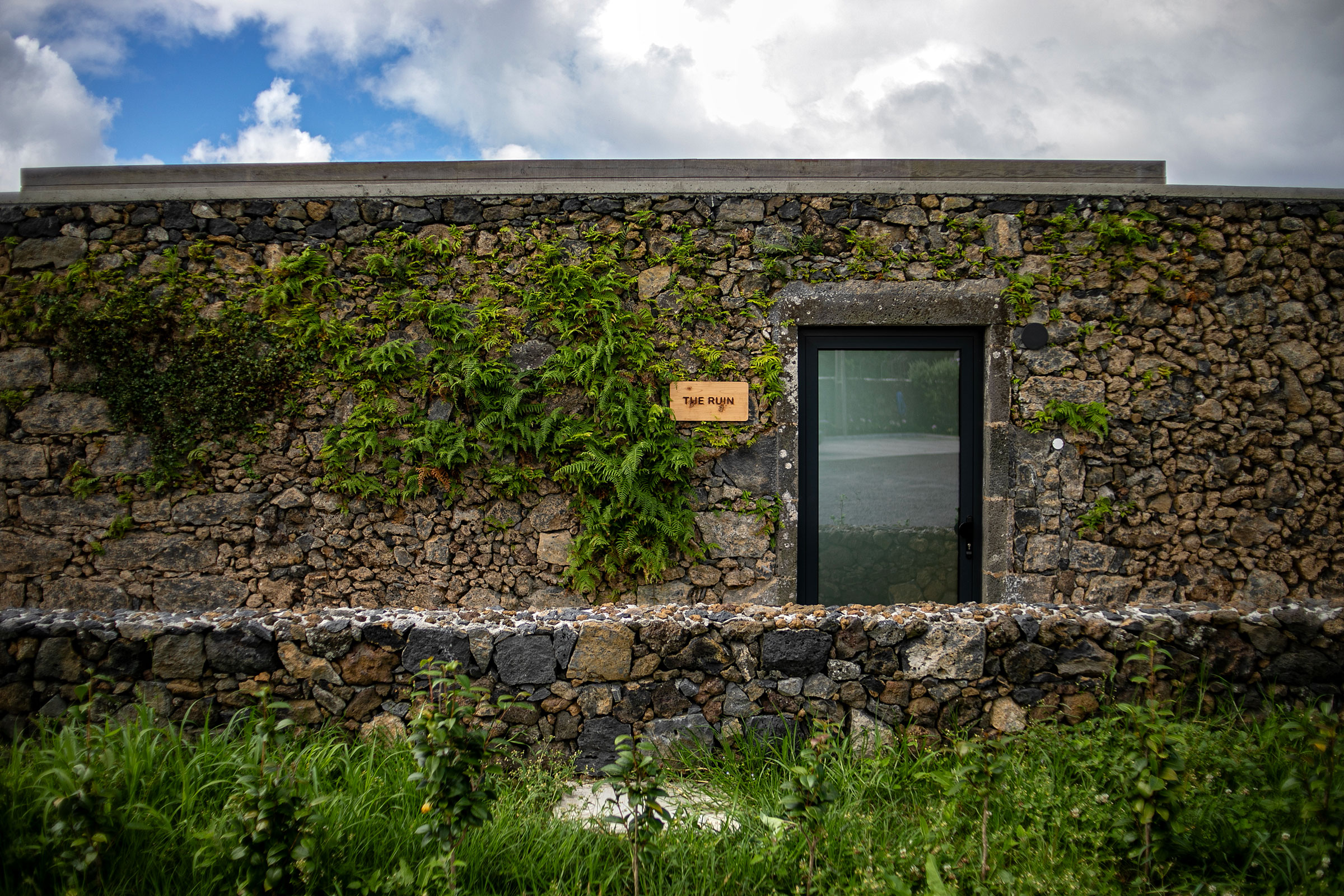
Called The Ruin, this two-story cottage was an abandoned farm building for decades before being brought back to life as part of Solar Branco. “We wanted to take something that was old and crumbling and restore it to something beautiful and comfortable,” says co-owner Caroline Sprod. Photo by Rui Soares
This eco-friendly ideology carries over into how the couple runs the estate, which is both plastic- and pesticide-free, produces zero food waste, and is expected to generate 80% of its own energy via renewable sources. Most of the décor, furnishings, and toiletries found at Solar Branco were sourced from small artisans throughout the Azores and Portugal at large, further reducing the hotel’s environmental footprint.
Sprod and Bullock also expect their guests to practice sustainability during their stay at the estate. Each guest room at Solar Branco is outfitted with an innovative resource monitoring system called My Green Butler, a program that measures guests’ individual resource usage in real-time and offers tips on how to reduce water and electricity consumption. The Solar Branco Eco Estate officially opened in 2023 and encompasses eight luxury suites.
6. Acton Passive House, Acton, MA
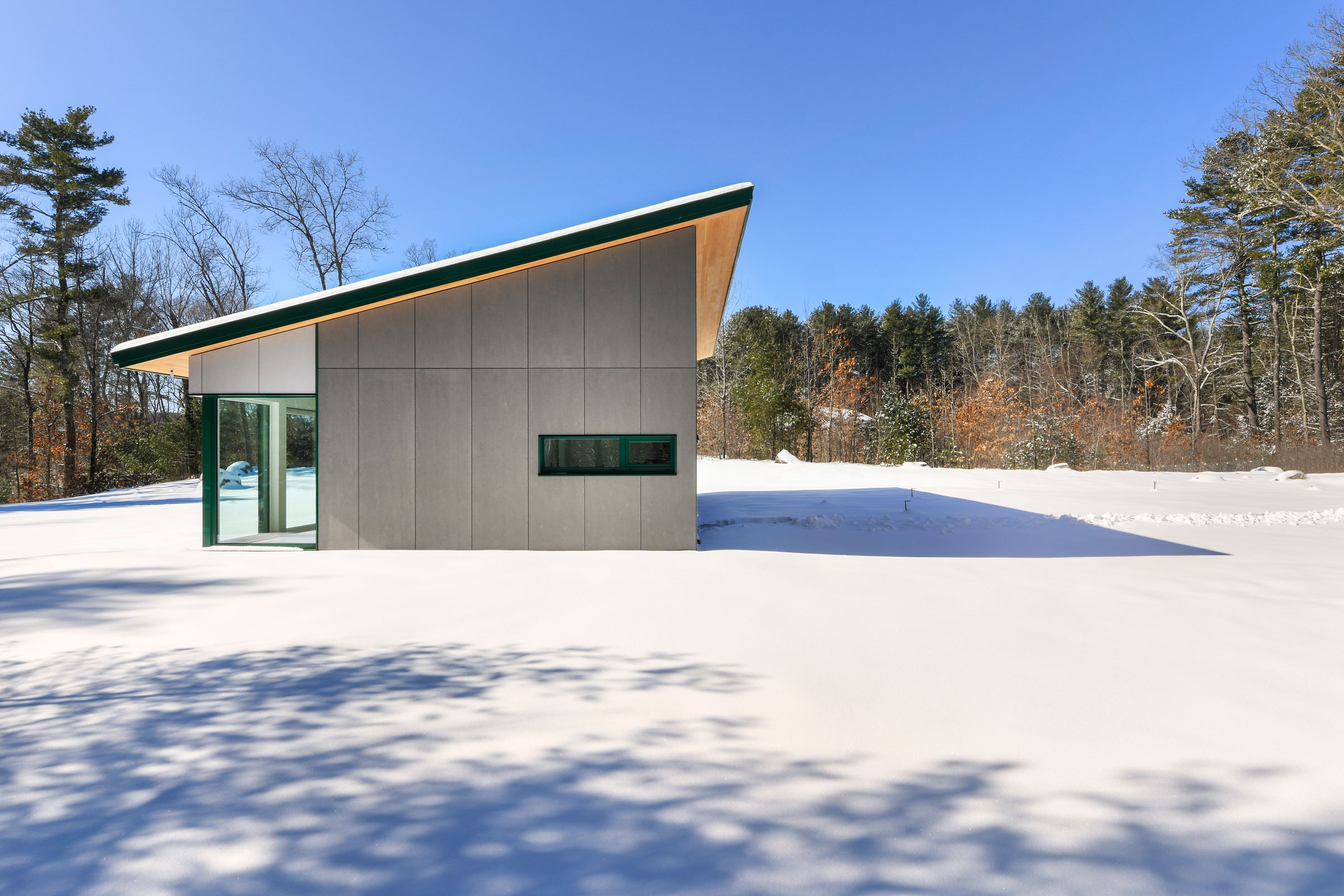
The Acton Passive House designed by ZeroEnergy Design is tucked into a clearing in the woods. Photo by Nat Rea
Designed by ZeroEnergy Design (ZED), the Acton Passive House in Acton, Massachusetts is a prime example of how sustainable building projects can leverage natural processes and phenomena to their advantage to ensure maximum energy savings.
Nestled into a remote clearing in the woods, the unassuming Acton Passive House—certified to both the PHIUS and Source-Zero standards—produces all of its own energy via a rooftop solar array and boasts incredible efficiency. Dense-packed cellulose insulation wrapped in wood fiberboard helps the building passively retain heat while also possessing a very low or negative embodied carbon. Rigorous air sealing and high-performance windows further serve to reduce the home’s energy consumption.
To minimize the home’s overall environmental impact ZeroEnergy Design elected to construct the Acton Passive House primarily from wood and fiber cement, reducing the amount of concrete required for the build.
“What we were able to do on this project was rely on a wood structure and minimize the concrete, which typically has the highest carbon impact. Through the process we wanted to make sure we weren’t just looking at operational carbon but also considering the embodied carbon—the carbon that goes into the construction,” Stephanie Horowitz, lead architect and managing director at ZED, previously told gb&d.
7. La Conner Swinomish Public Library, La Connor, WA

An 18-foot tall cedar story pole was hand-carved with traditional iconography from Coast Salish culture for the front of the La Conner Swinomish Public Library. Photo by Doug Scott
When the small maritime town of La Conner, Washington decided to upgrade its 1,500-square-foot one-room library, the neighboring Swinomish Indian Tribal Community became one of the project’s largest benefactors. This partnership is reflected in the completed La Conner Swinomish Public Library—designed by the BuildingWork architect team—whose design honors elements of both Coast Salish culture and the town’s historic past.
The first thing patrons see when they arrive at the new library is the 18-foot tall cedar story pole standing outside the front entrance. Designed by Kevin Paul, a Swinomish elder and master carver, the story pole depicts a traditional Salish person with outstretched hands at its base, two salmon to represent sustenance and resources, and an eagle at its peak to represent wisdom.

Large and round light fixtures by Louis Poulsen hang like spotlights over the reading areas inside the La Conner Swinomish Library. Photo by Doug Scott
When it comes to the building itself the library is constructed almost entirely from locally-sourced cross laminated timber, a low-carbon engineered wood product with a high compression strength similar to that of concrete. Wood cladding and detailing, along with decorative cornices and vertically proportioned windows, helps the building emulate the style of La Conner’s historic 1800s-era architecture.
“We’re proud of how it came out from a design standpoint,” Matt Aalfs, founder and principal architect of BuildingWork, told gb&d in a previous article. “It was a wonderful opportunity to figure out how the architecture could reflect native culture in a really authentic way and present a public space that is welcoming to everyone.”
8. Annie E. Fales Elementary School, Westborough, MA

As design progressed HMFH looked for ways to limit energy use. The sawtooth roof helped maximize the surface area for south-facing PV panels and north-facing skylights. All of the glazing on the facade is triple- glazed to add more thermal insulation. Photo by Ed Wonsek
As the first net-positive energy public school in New England, the Annie E. Fales Elementary School in Westborough, Massachusetts blends sustainable and educational design to foster a sense of environmental and social responsibility in young students from an early age.
Also designed by HMFH Architects, the Annie E. Fales Elementary School earned net-positive status by employing a rooftop photovoltaic solar grid and 40 geothermal wells to generate its power. HFMH chose to install a sawtooth roof in order to maximize surface area for the school’s south-facing PV panels and increase their efficiency. All in all these renewable energy systems allow Fales to produce 11.6% more energy than it needs.
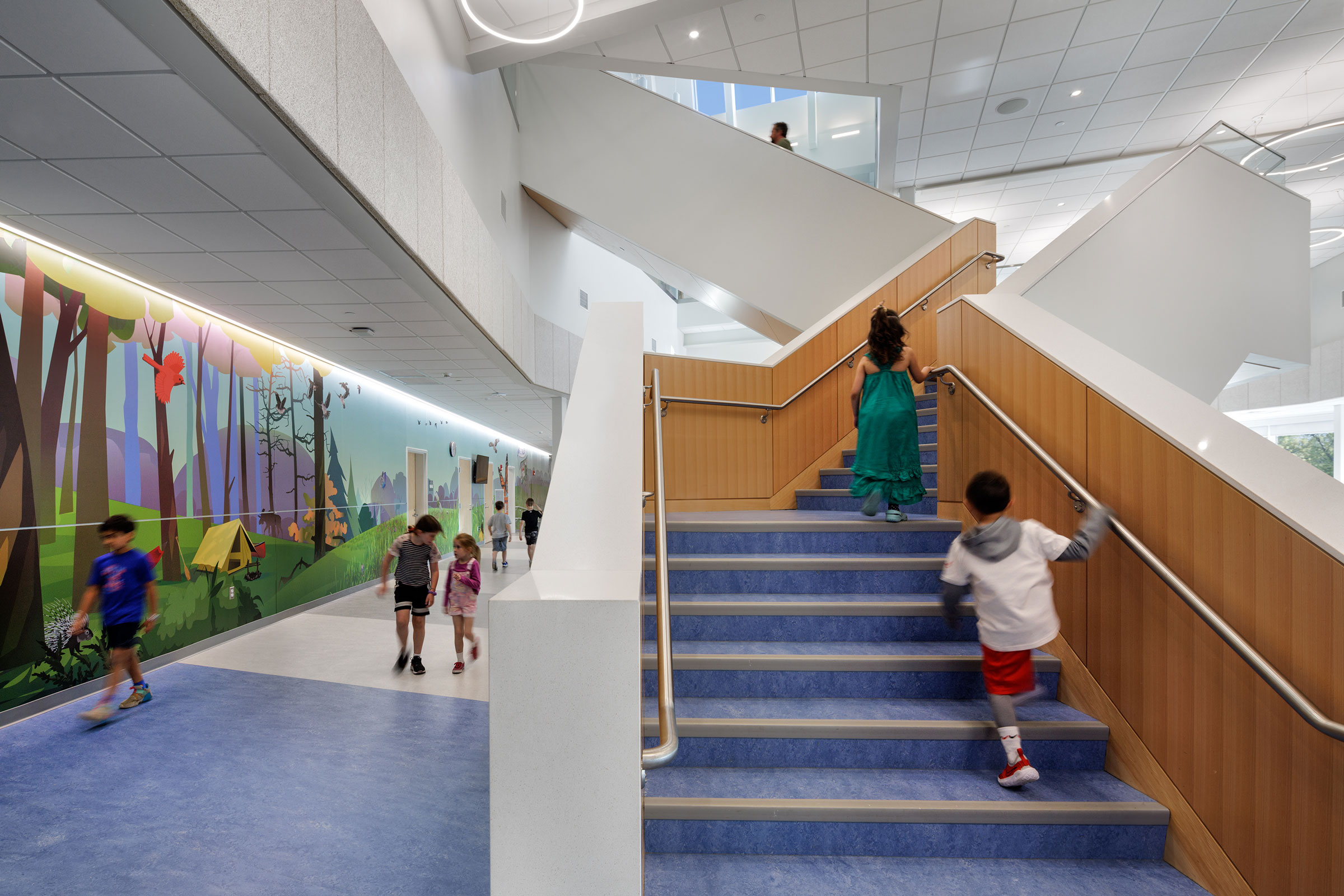
Natural light filtering through the clerestory windows helped Fales achieve net-positive energy status. While the school didn’t require as much electricity, HMFH worked with LAM Partners for indoor lighting. LAM Partners wanted to keep the light power density low while still creating and maintaining well-lit spaces. Photo by Ed Wonsek
Fales’ interior learning areas are organized into four project areas, each of which are centered around different landscapes found in Massachusetts: forest, meadow, marshland, and pond. Each area corresponds to a specific grade level and boasts a unique, biome-specific color palette as well as storybook-style murals.
“The murals help get the students excited about where they live, wanting to get out and explore as well,” Caitlin Osepchuk, project architect and associate at HMFH Architects, told gb&d in a previous article. “And foster that love of the environment so they’ll continue to make positive sustainable choices in the future to help maintain the ecosystems they live in.”
9. Casa Adelante, San Francisco
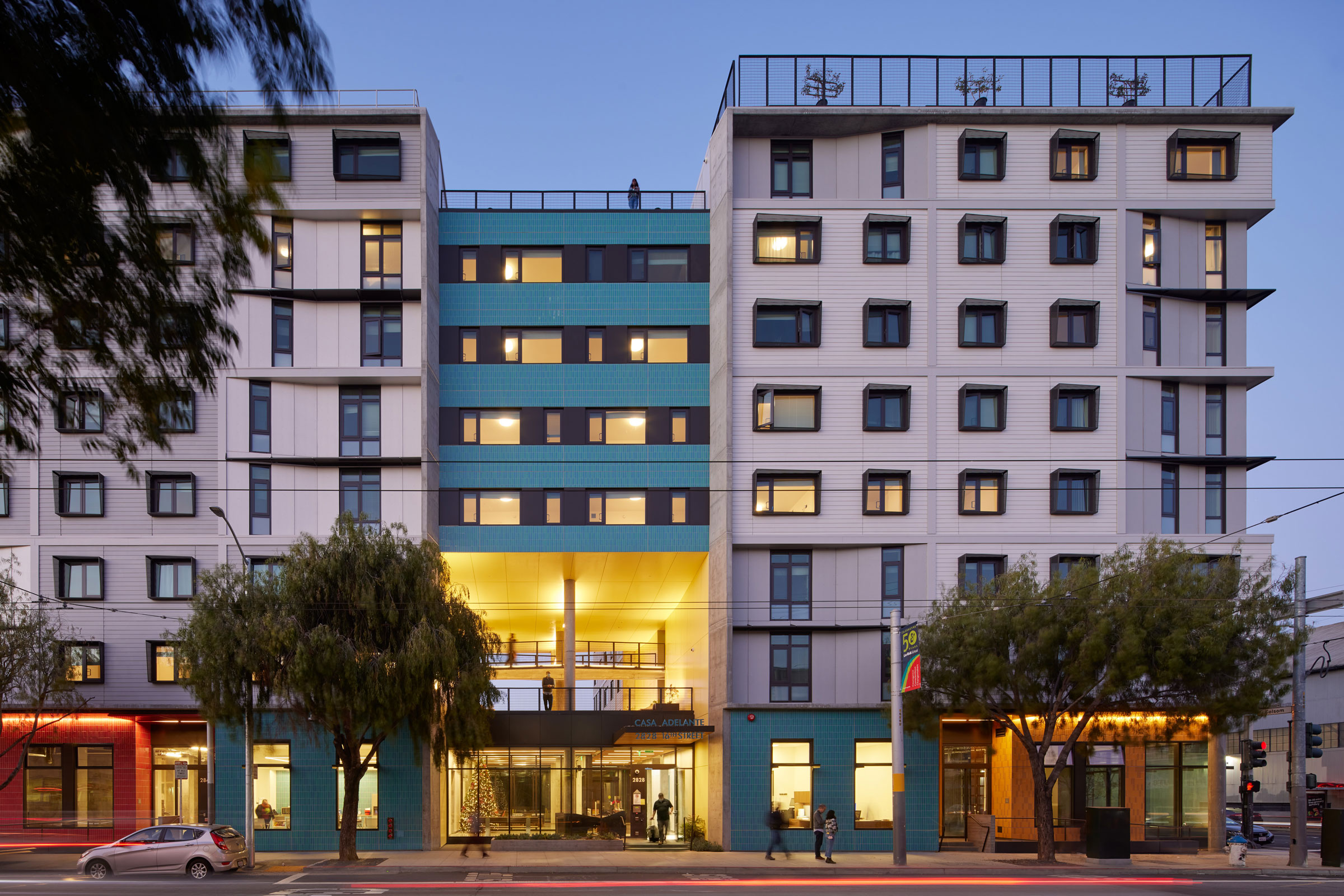
Leddy Maytum Stacy Architects worked with Mission Economic Development Agency and the Tenderloin Neighborhood Development Corporation to foster and celebrate an interconnected and vibrant community as part of the Casa Adelante 2828 16th Street project. The colorful tiles seen on the exterior are from Daltile’s Natural Hues Collection. Photo by Bruce Damonte
Designed by Leddy Maytum Stacy Architects (LMSA), the Casa Adelante 2828 16th Street housing project in San Francisco’s Mission District—an area populated largely by families of Latin American descent—proves cultural and environmental sustainability need not be sacrificed in the name of affordable housing.
Casa Adelante encompasses 143 total residential units, a childcare center, art gallery, community room, and a youth organization, as well as gardening spaces on the 7th floor and roof. These spaces are dedicated to urban agricultural food production and allow residents to grow their own produce, strengthening food security and encouraging the teaching of traditional food-ways.
“Food insecurity is a very big and valid concern for the populations the building serves,” Ryan Jang, principal at LMSA, told gb&d in a previous article. “This idea of combining food and housing security together helps with these huge housing issues that are present in San Francisco and elsewhere.”

Landscape Forms MultipliCITY collection is at home on the rooftop deck alongside stone counters from Absolute Black Granite. Photo by Bruce Damonte
Given California’s propensity for natural disasters, Casa Adelante also features a range of precautionary and preparedness measures. The building’s ground floor is raised above the floodplain and any water that is not retained by the roof’s agricultural beds is routed to large stormwater planters in the building’s inner court/adjoining residential open space—both of which help reduce flood risk. A centralized ventilation and air filtration system ensures that residential units will receive clean air even when the skies are filled with smoke from wildfires.
Casa Adelante’s interior receives plentiful natural light and primarily features concrete, metal, fabric, FSC-certified wood, and other sustainable materials. All of the rooms on the building’s ground floor are open and interconnected to facilitate interaction and engagement amongst families and community members.
“It’s really about fighting displacement within another predominantly Latin American community,” Jang says. “It’s about what we with MEDA (Mission Economic Development Agency), our client, call cultural resilience and cultural preservation, fighting against gentrification and displacement so families can find a way to live affordably within the neighborhoods and community they’ve been a part of for a long time.”
10. Powerhouse Brattørkaia, Trondheim
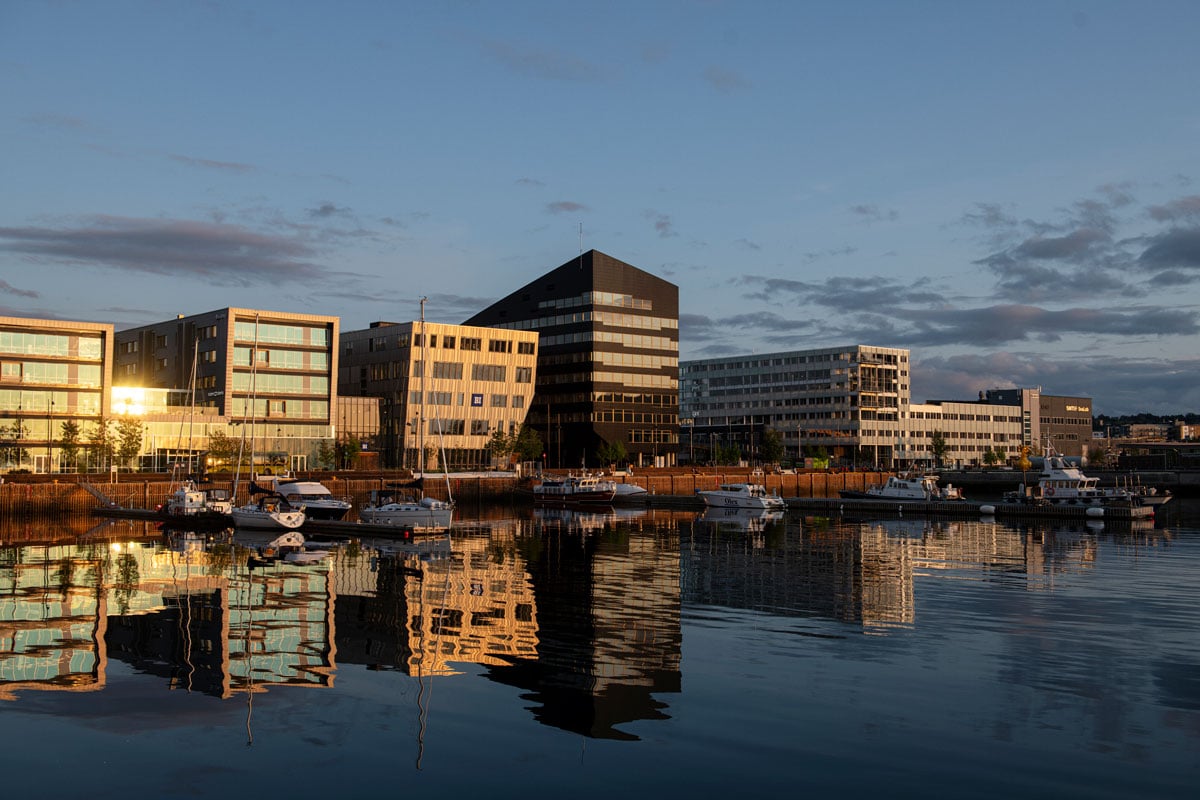
Norway’s Powerhouse Brattørkaia is the largest energy-positive building in Scandinavia. Photo by Ivar Kvaal
As Scandinavia’s largest energy-positive building, the Snøhetta-designed Powerhouse Brattørkaia is nothing short of a green-engineering marvel. Located in Trondheim, Norway the Powerhouse Brattørkaia office building features a 3,000 m2 solar grid capable of producing a whopping 485,000 kWh annually—enough to power itself, surrounding buildings, and more than 200 electric vehicles.
Brattørkaia’s ultimate goal, however, is not just to maximize the amount of clean energy it produces, but to minimize the amount of energy required to run it in the first place. To accomplish this Snøhetta employed a variety of energy-saving strategies, including: highly efficient insulation, energy-efficient appliances, a seawater-based heating and cooling system, intelligent airflow solutions, and heat-recovery measures.
Powerhouse Brattørkaia was also designed so as to make the effective use of natural daylight throughout the year, drastically reducing the need for artificial lighting.

